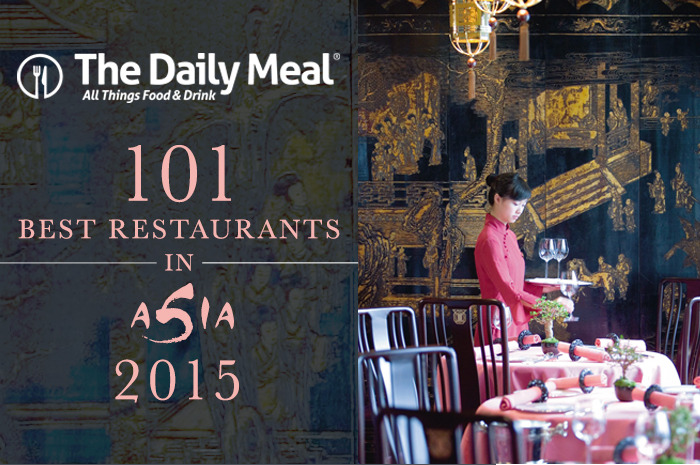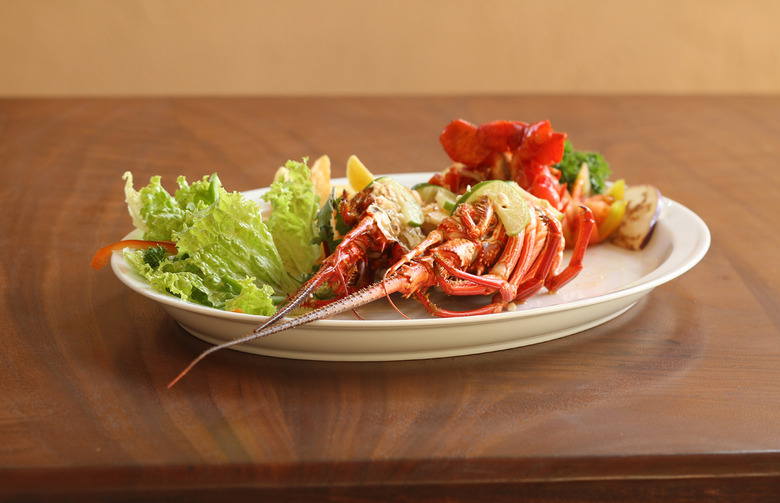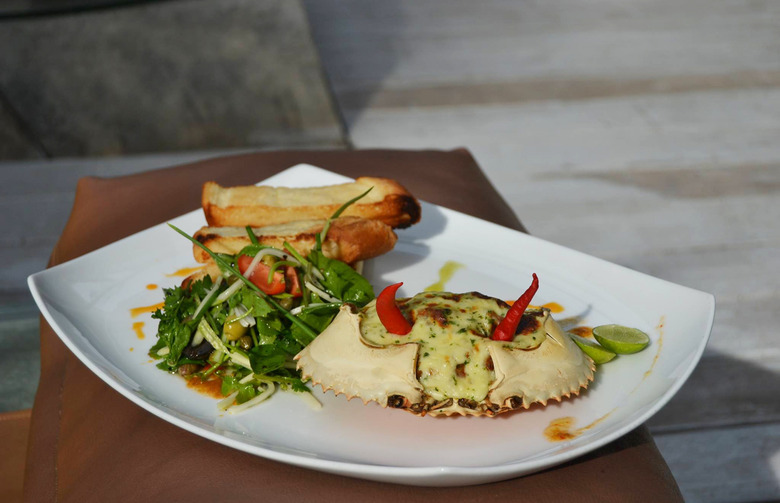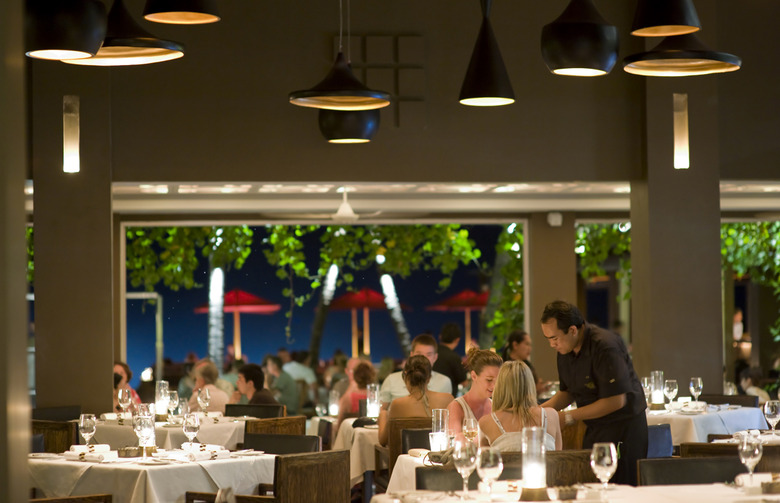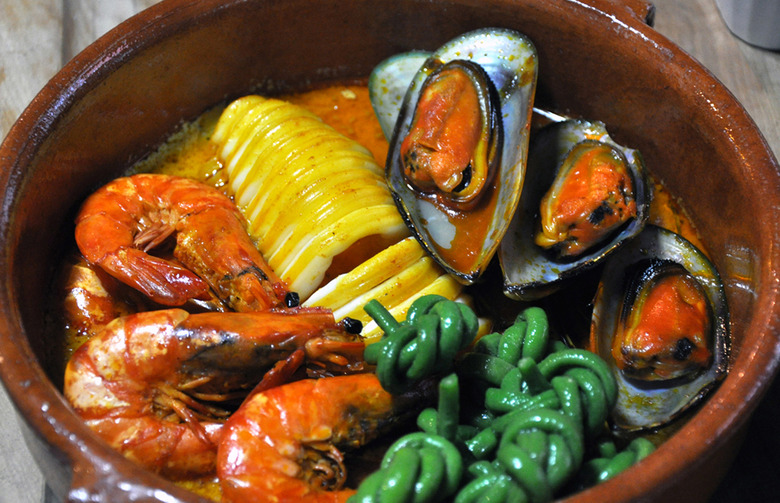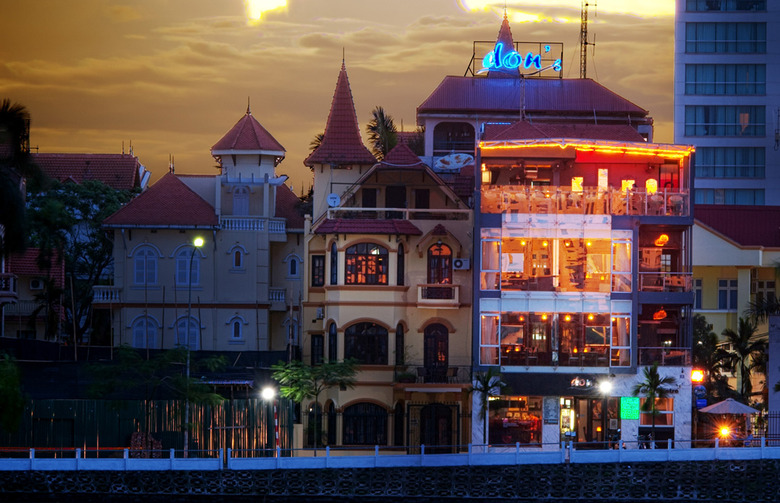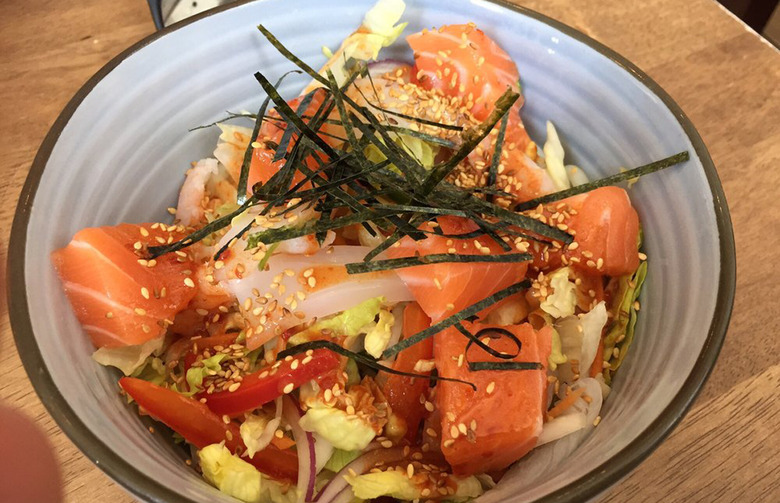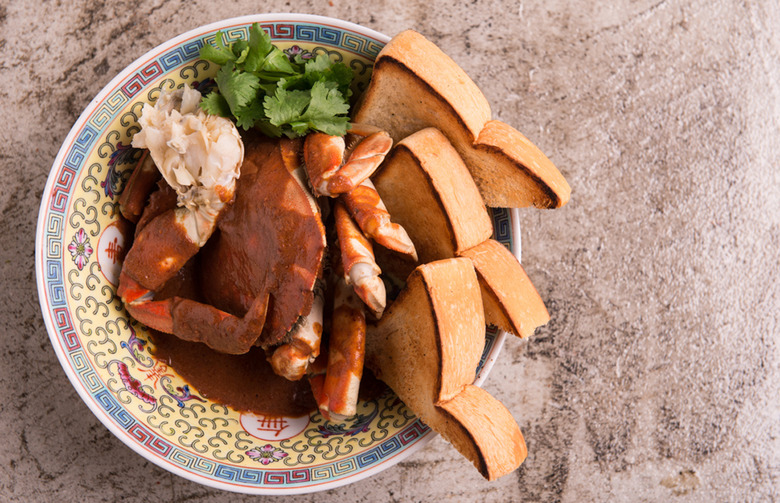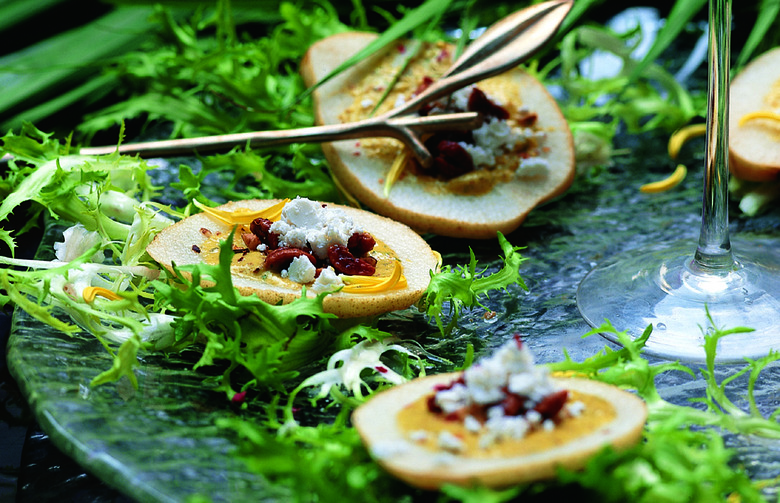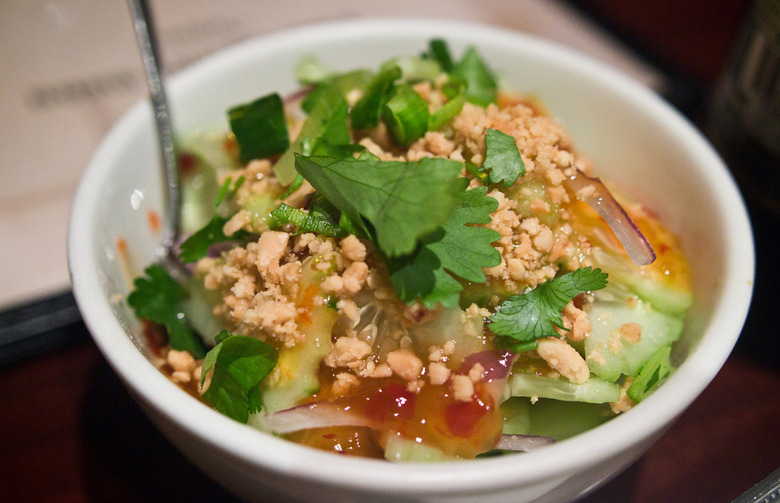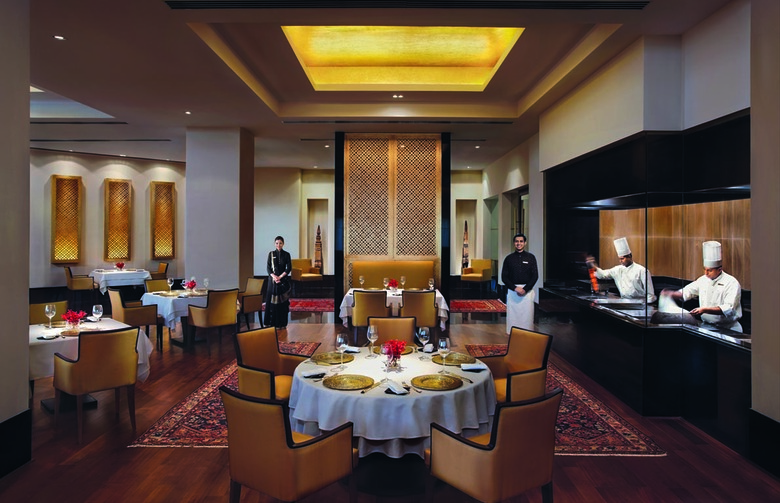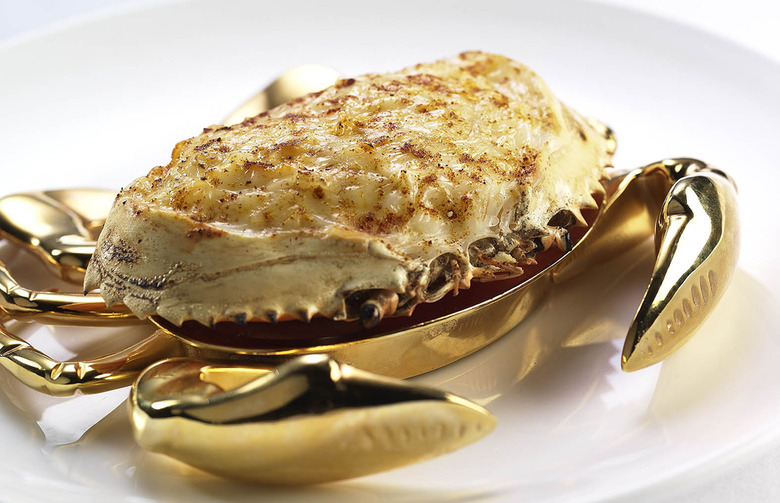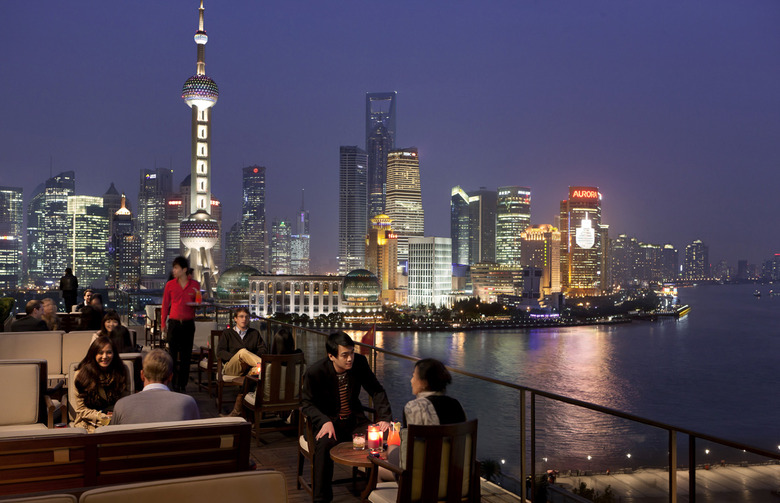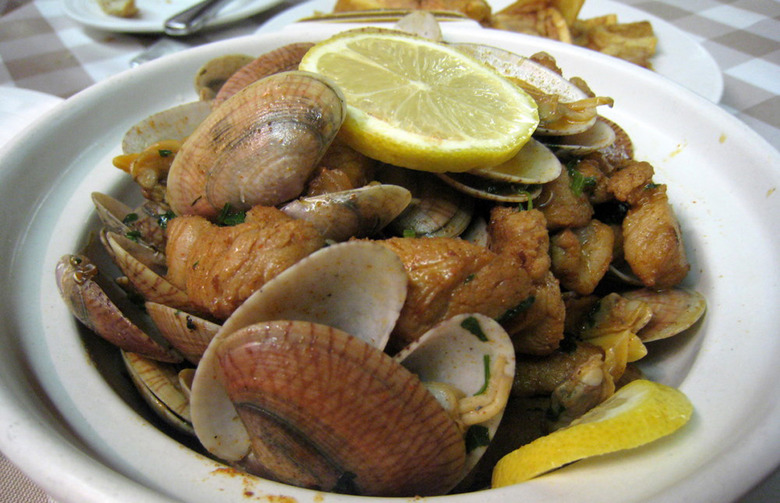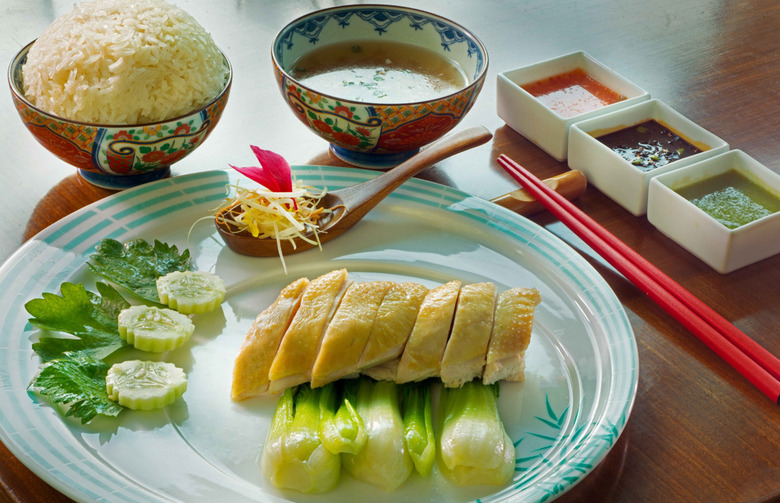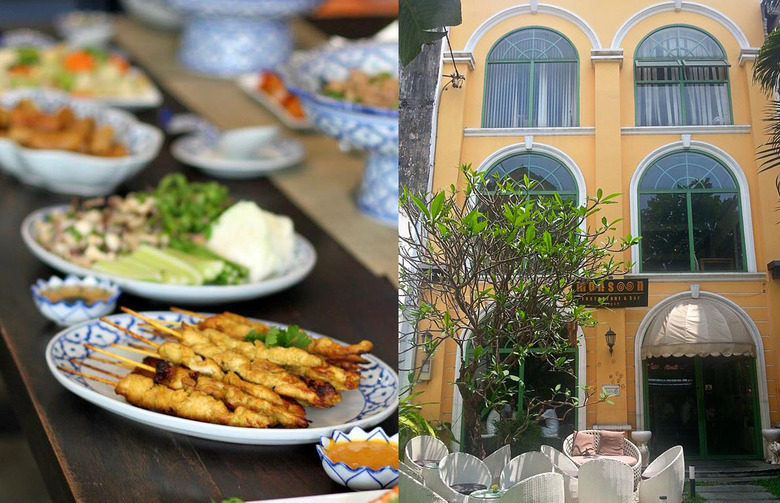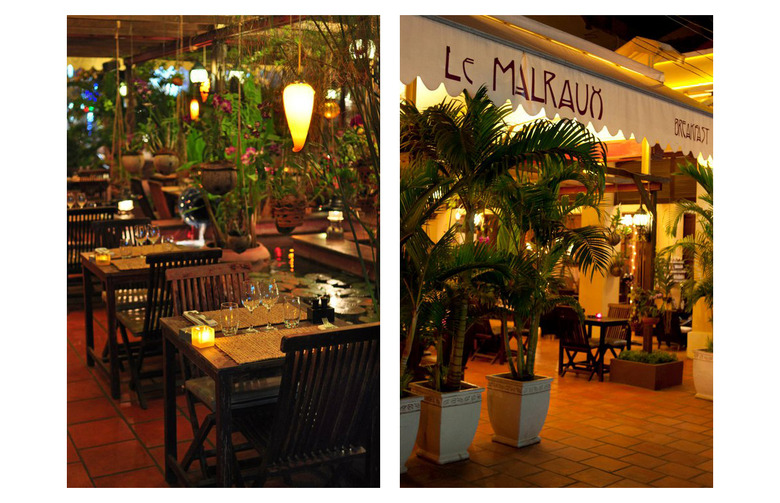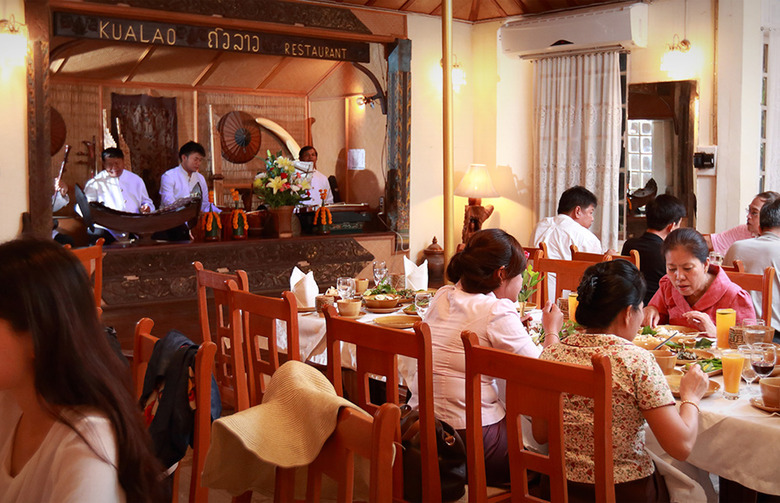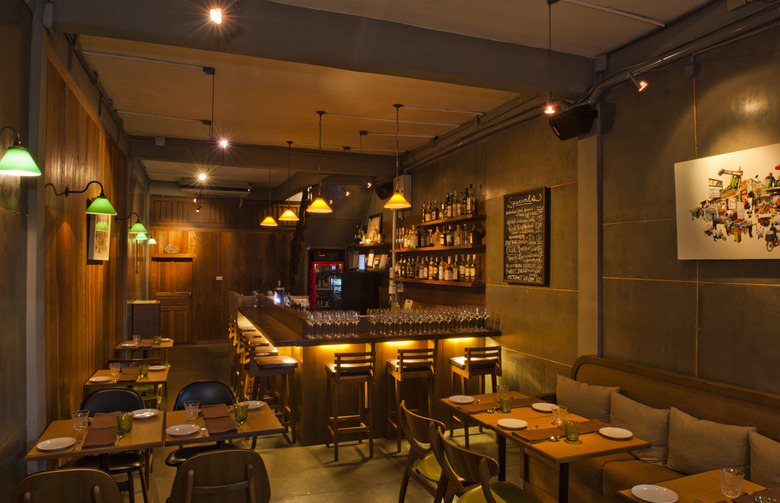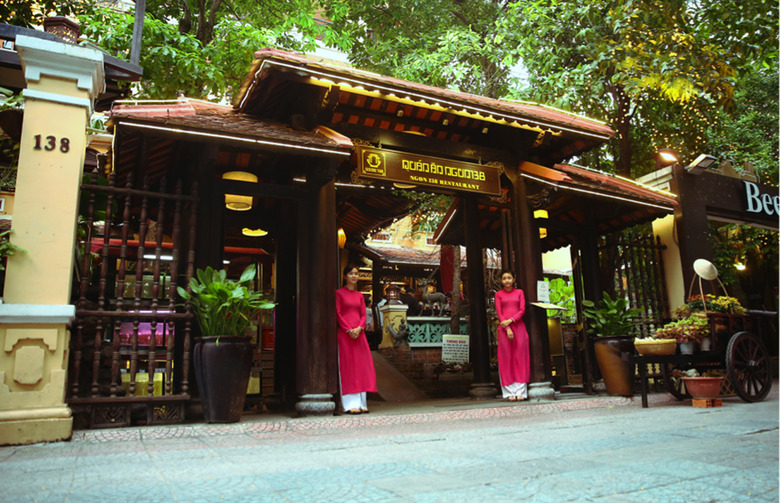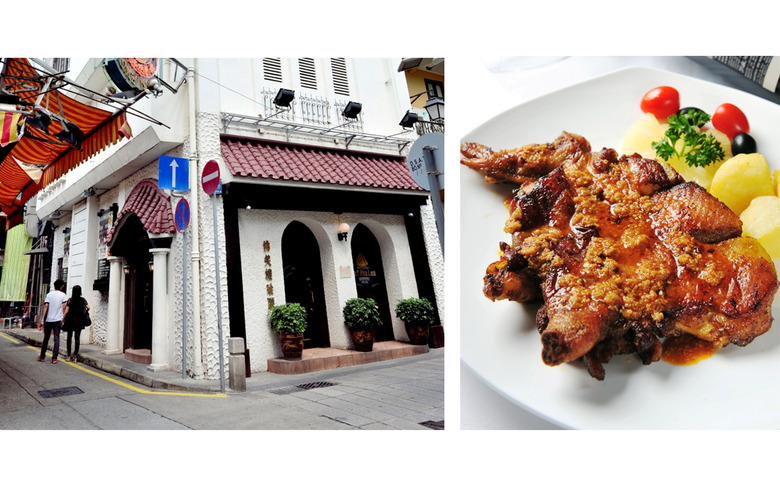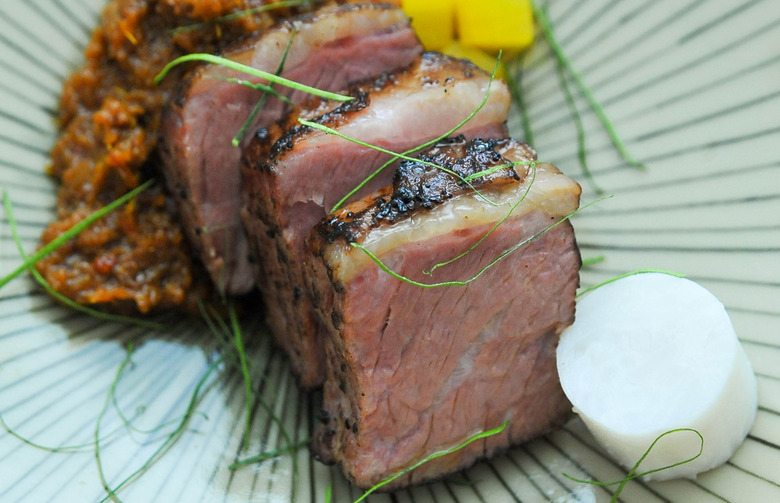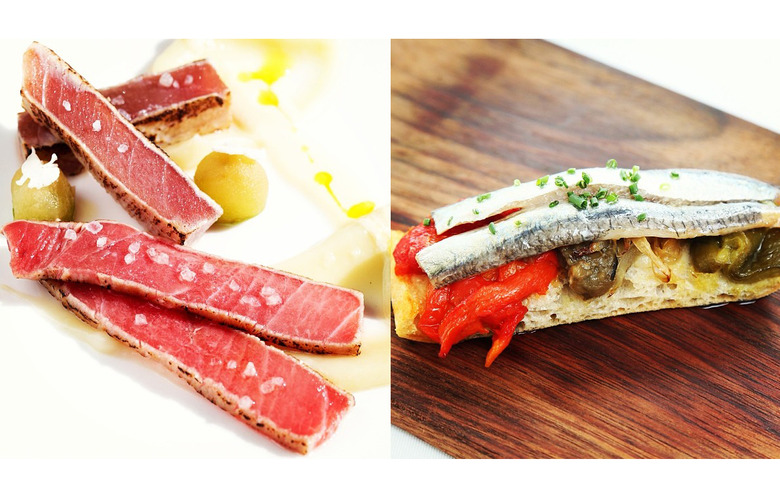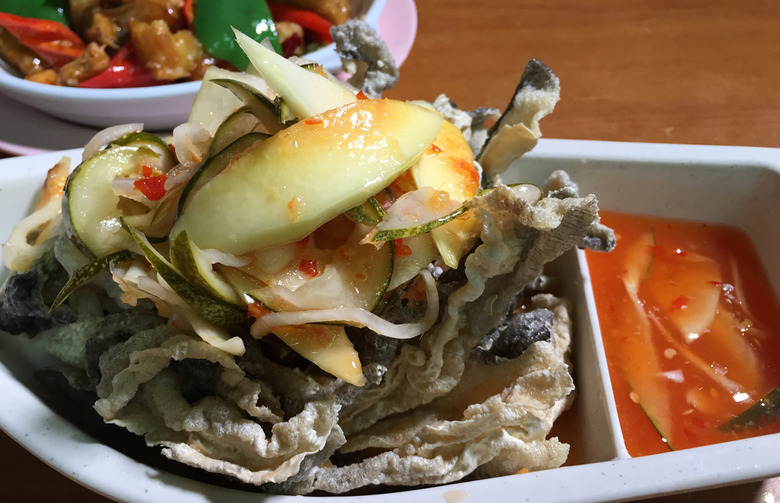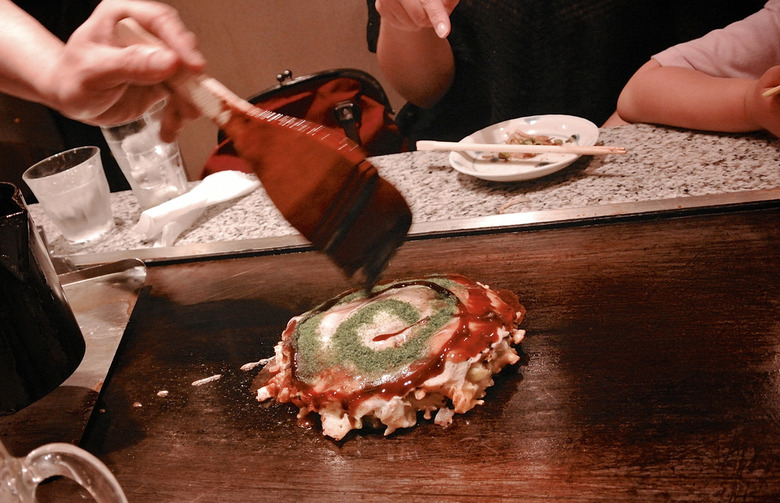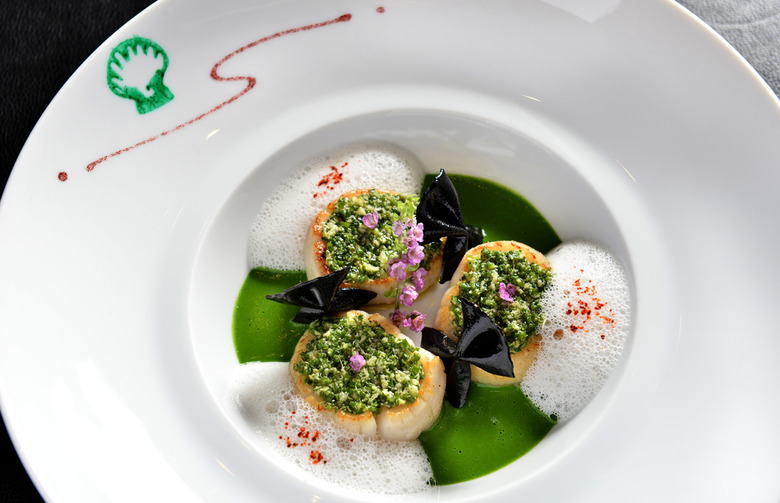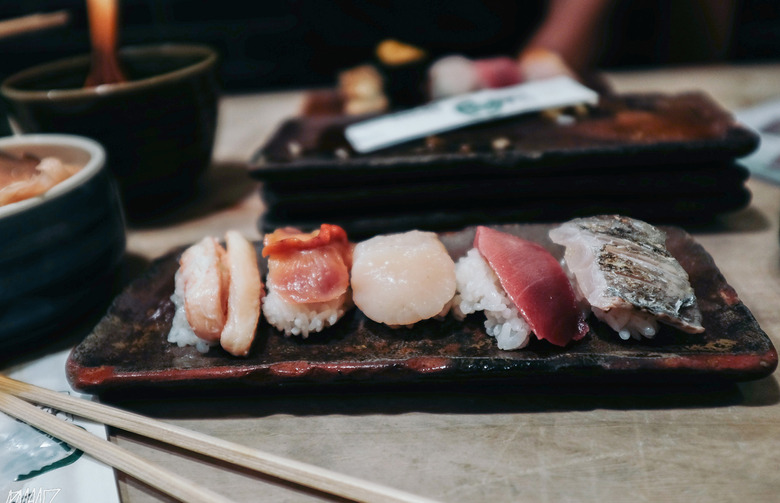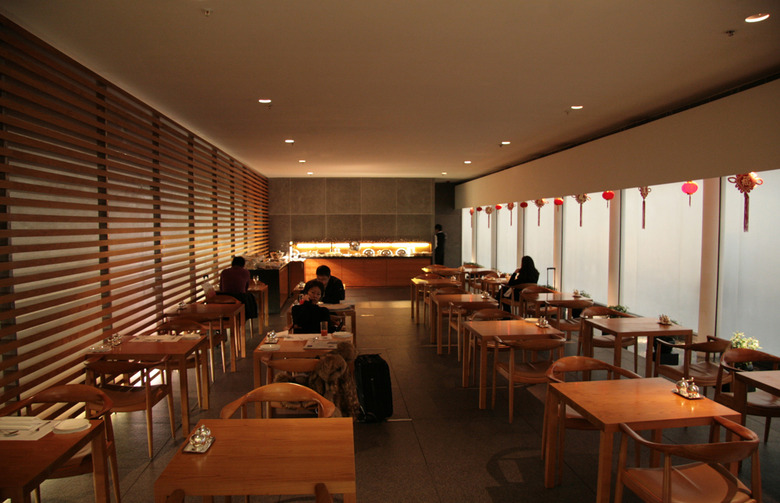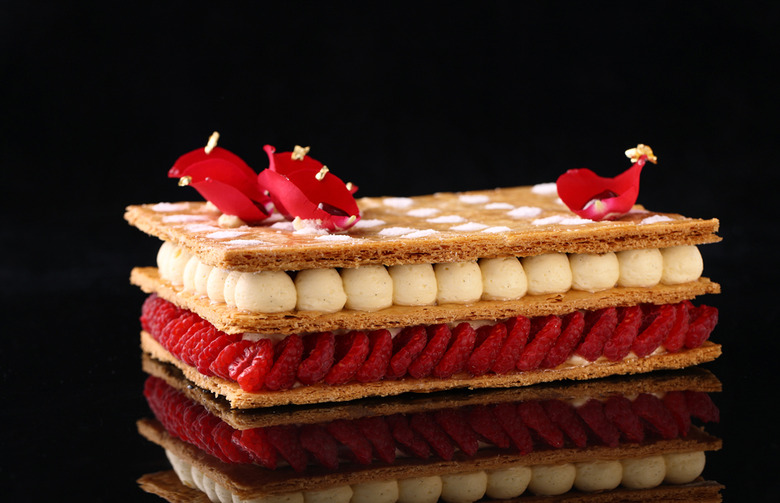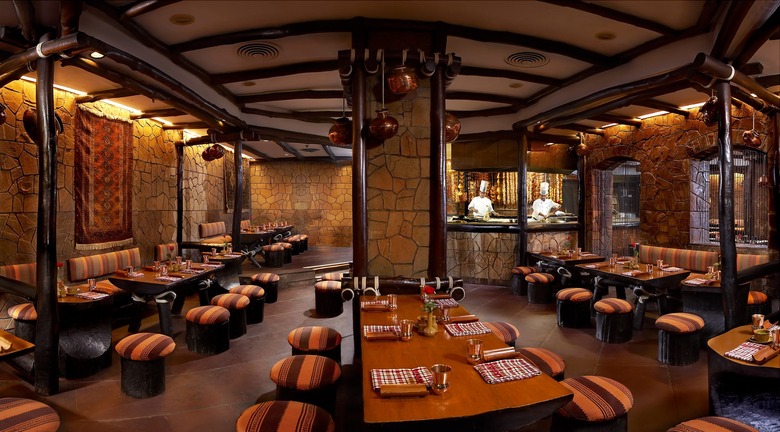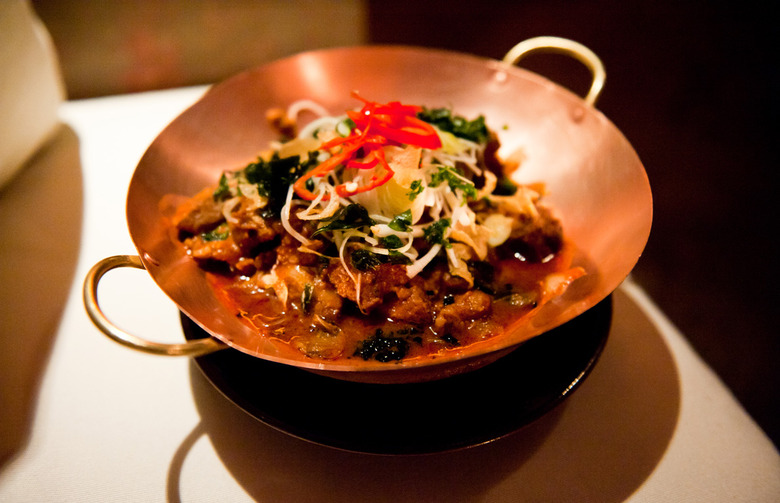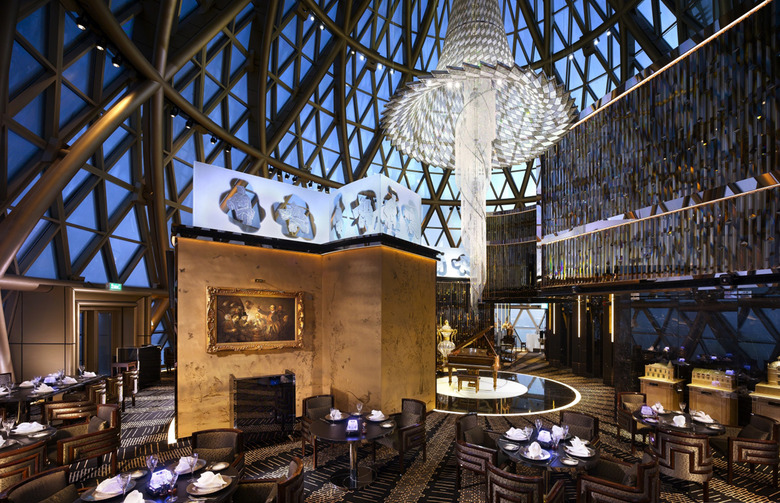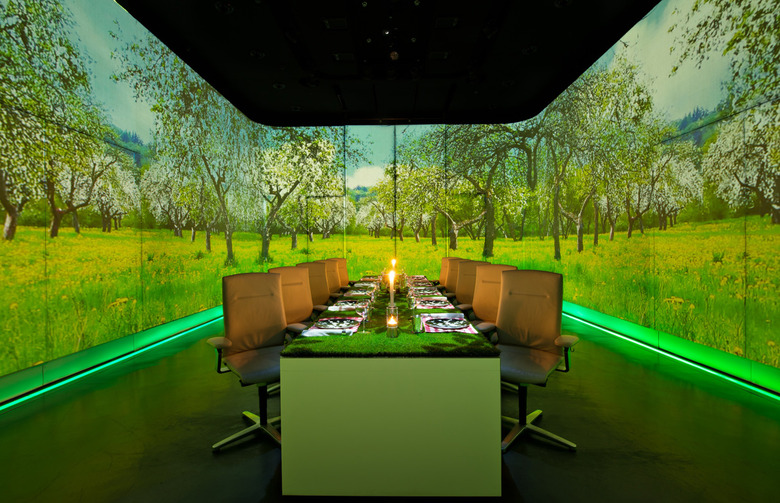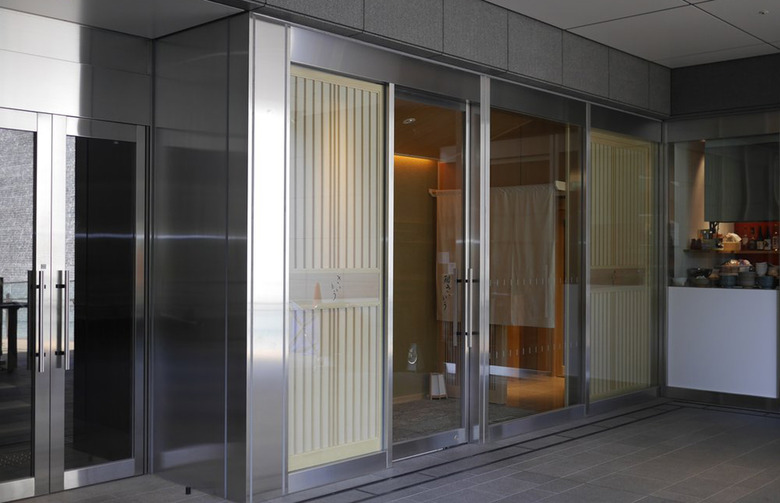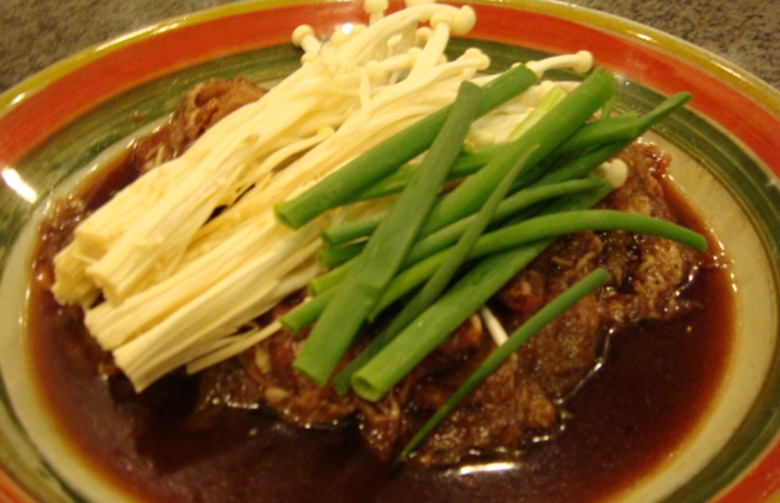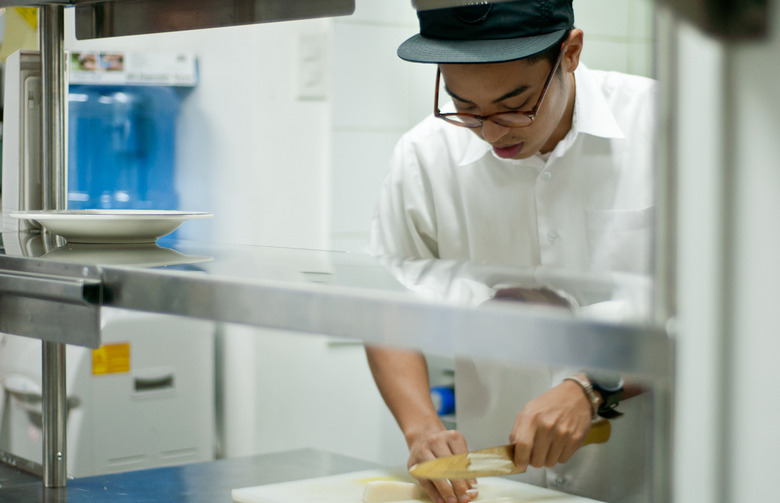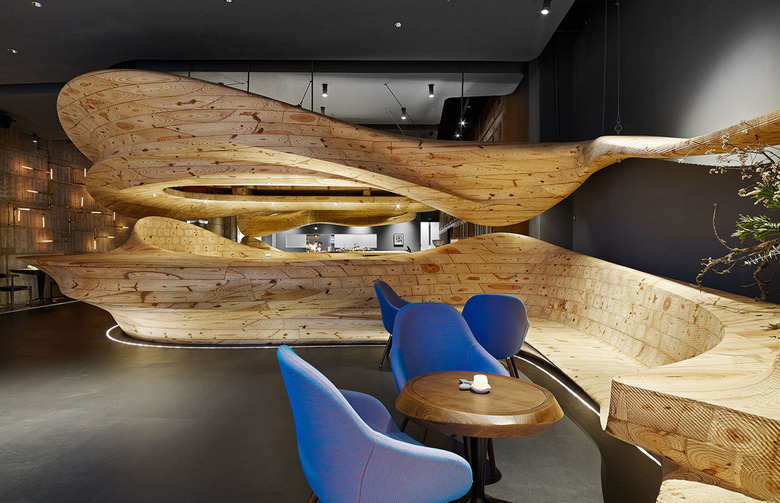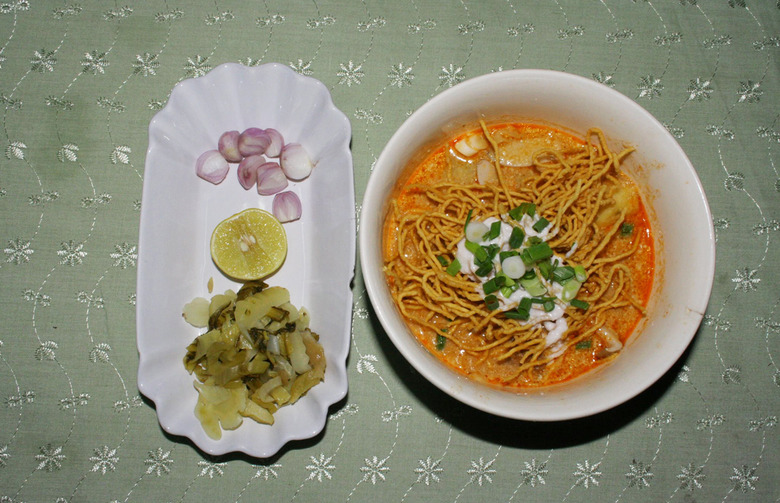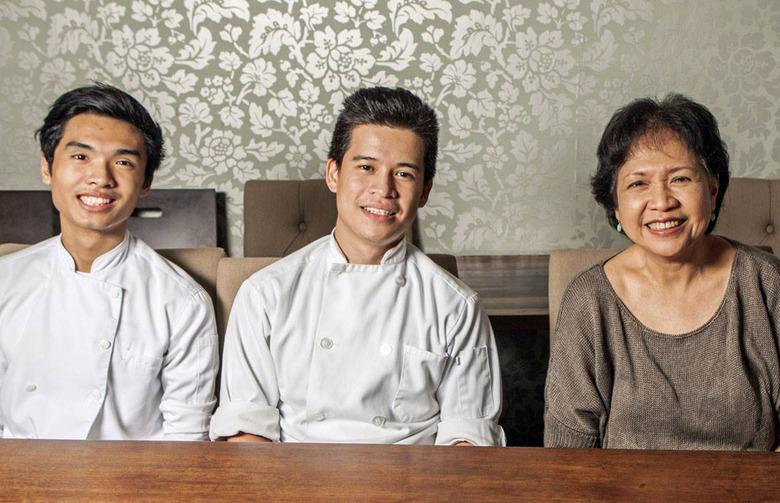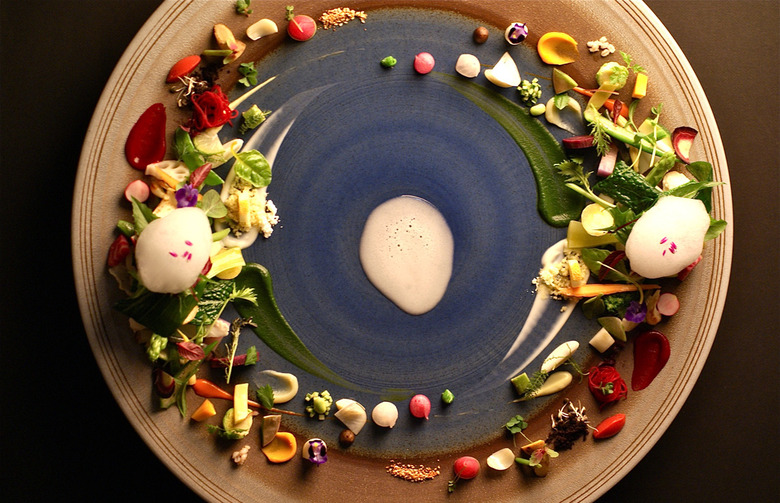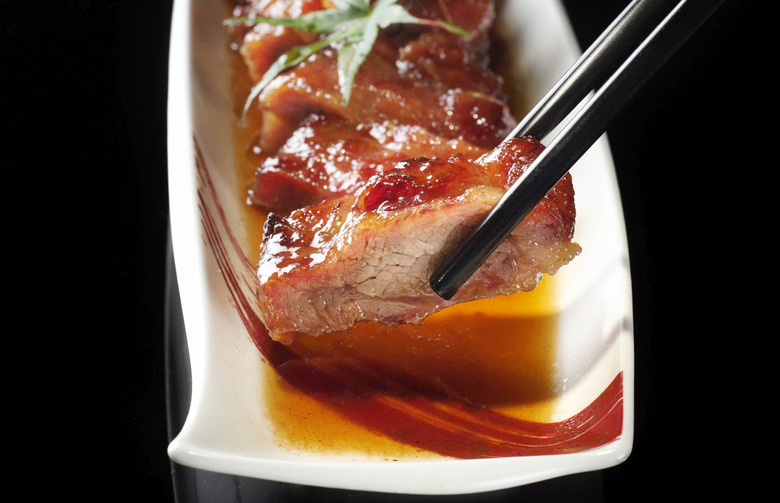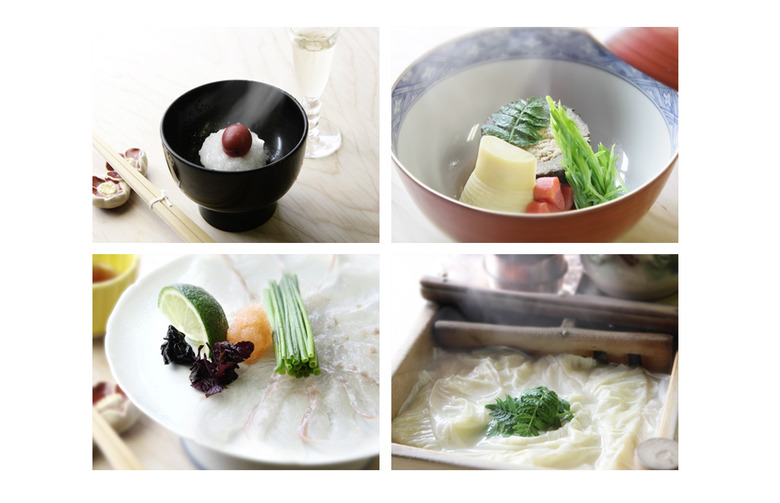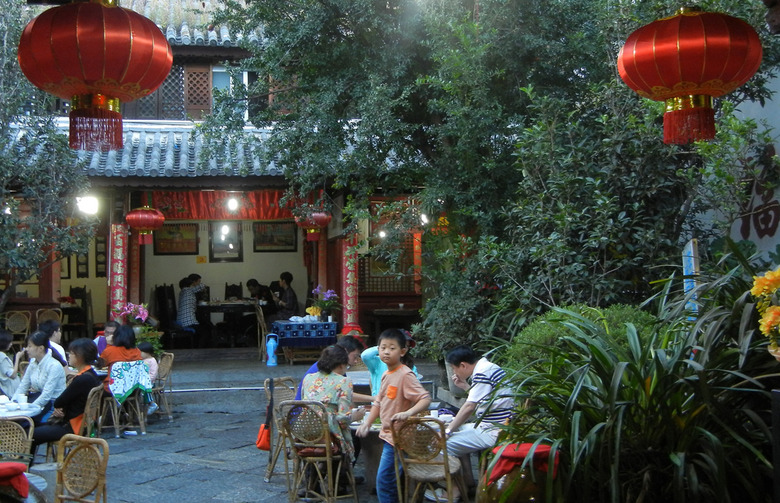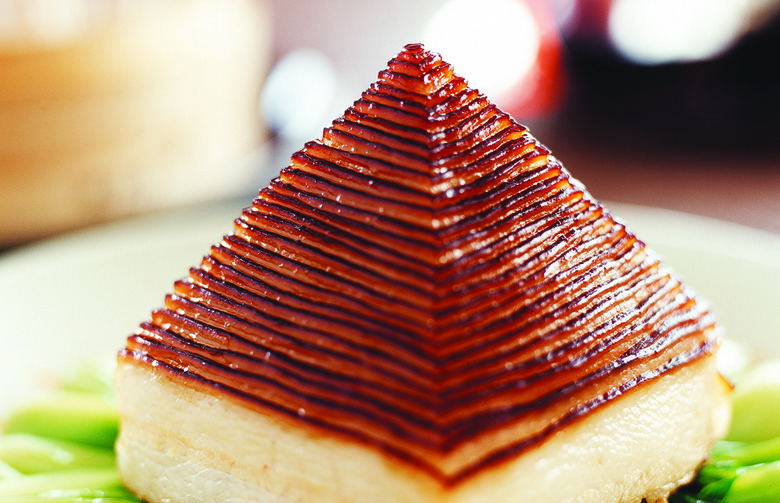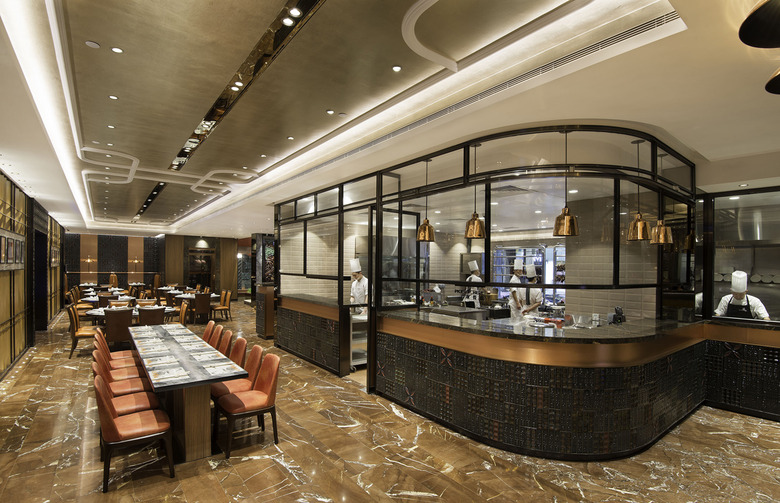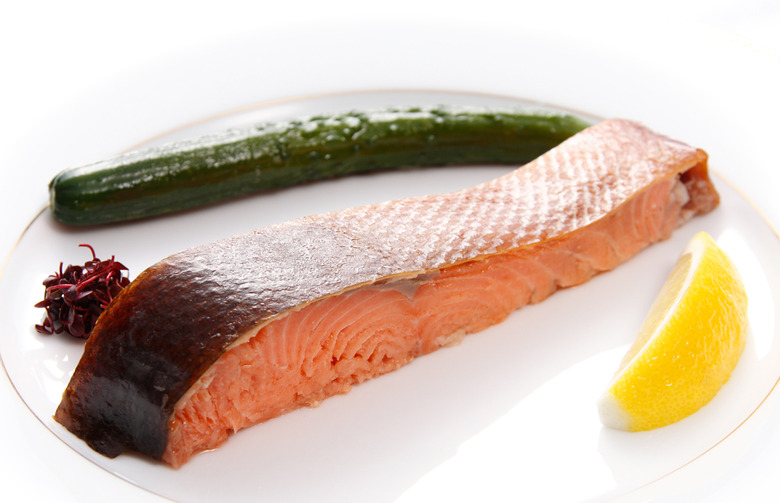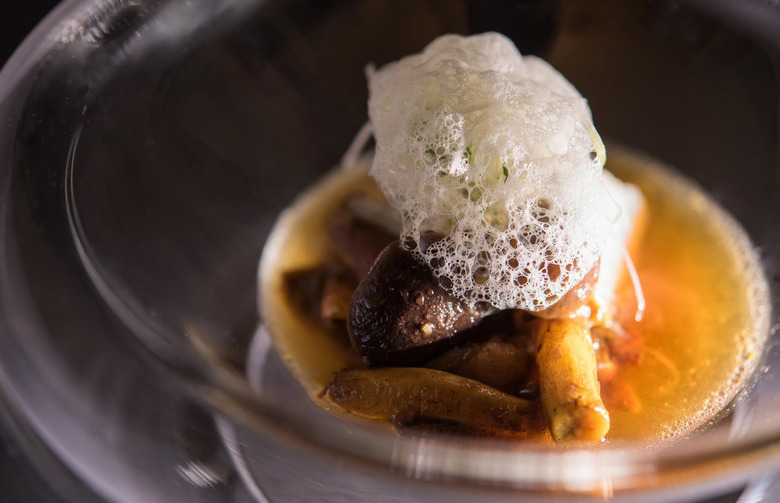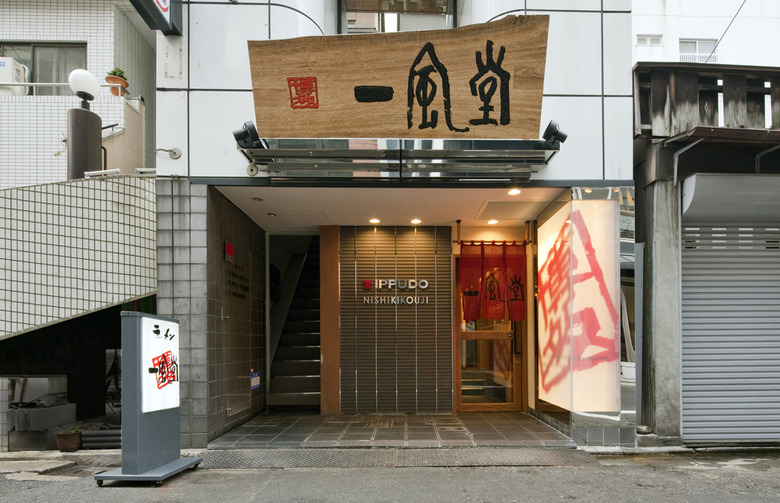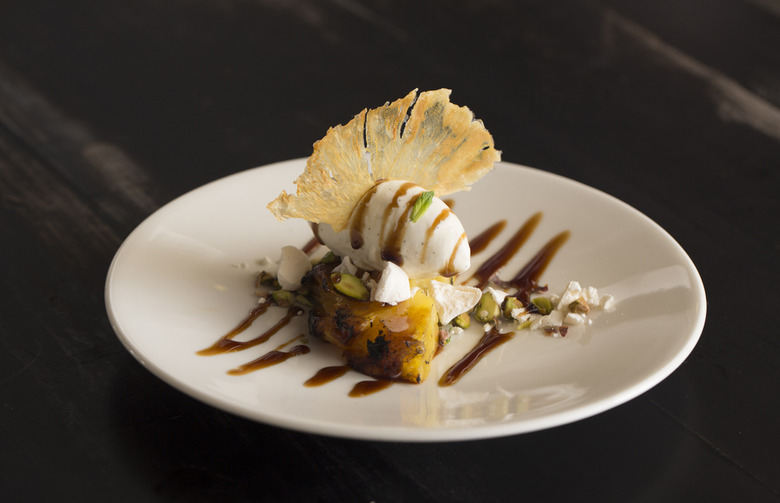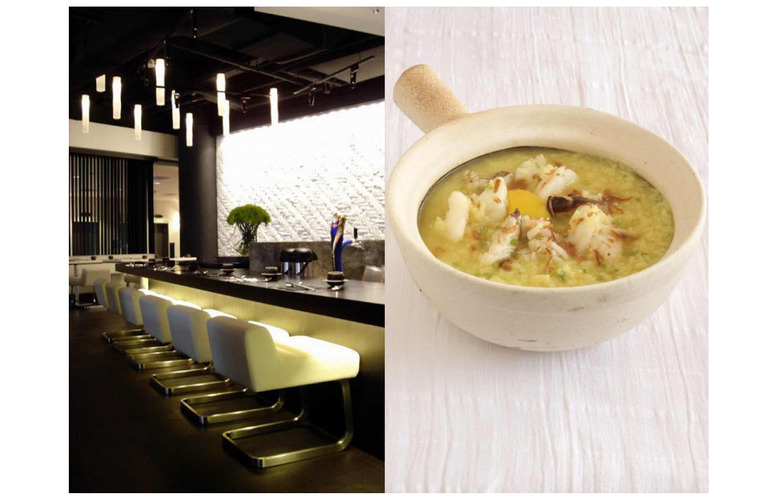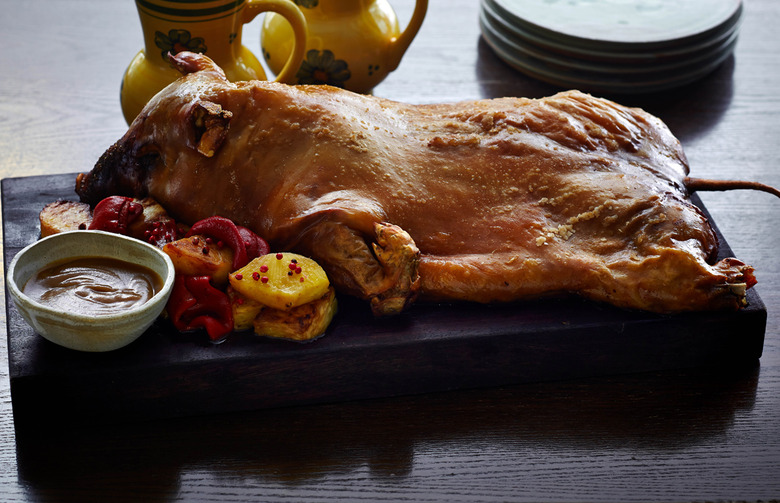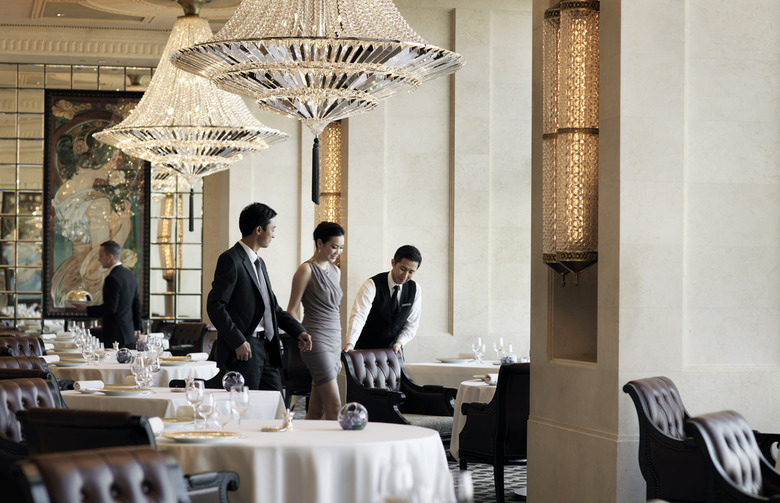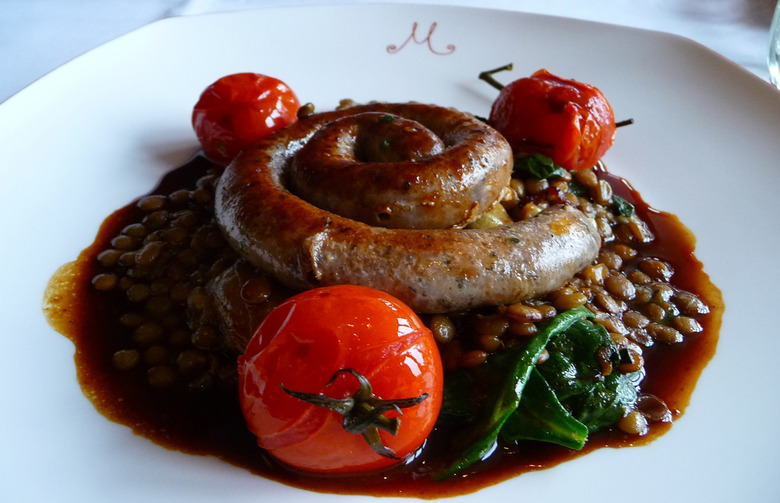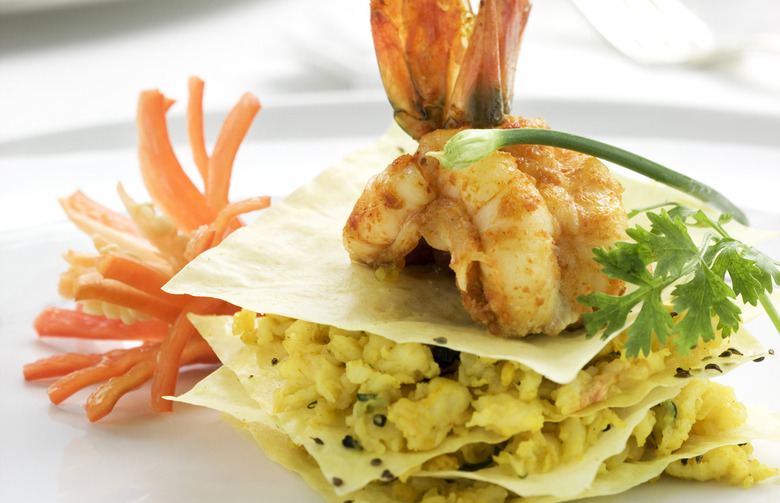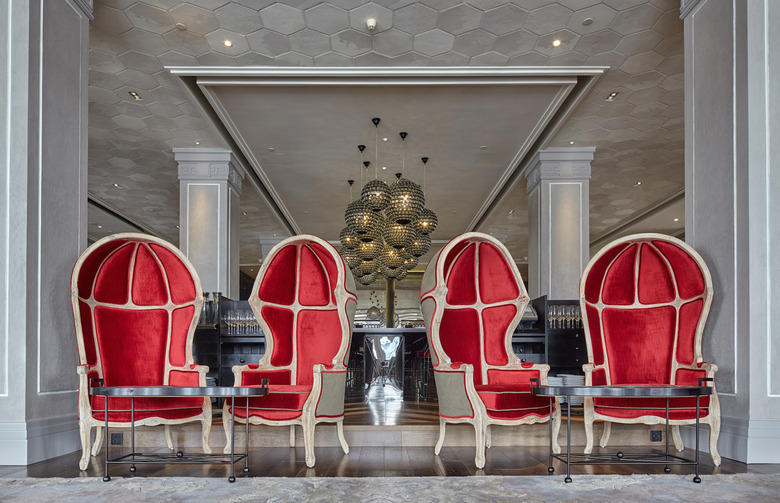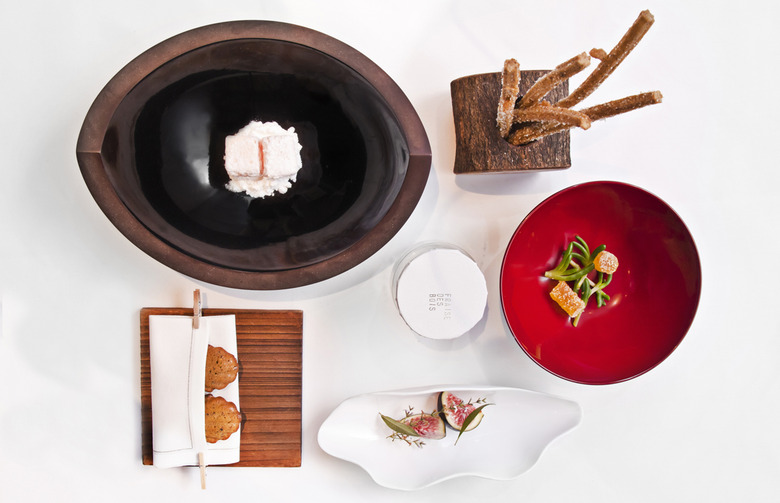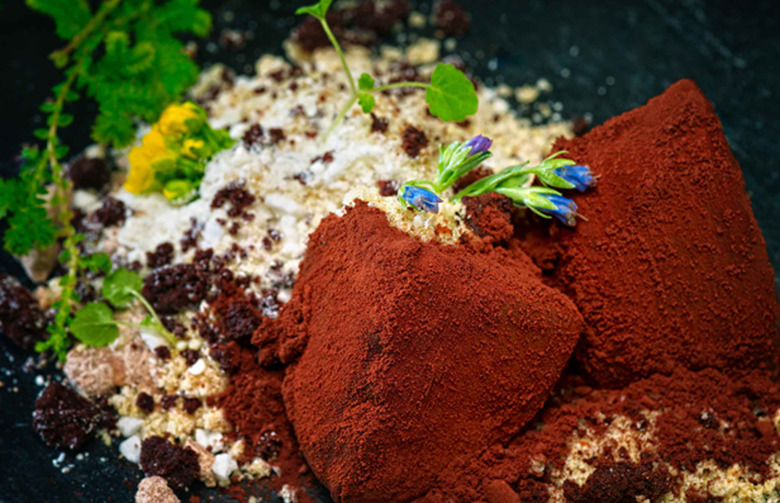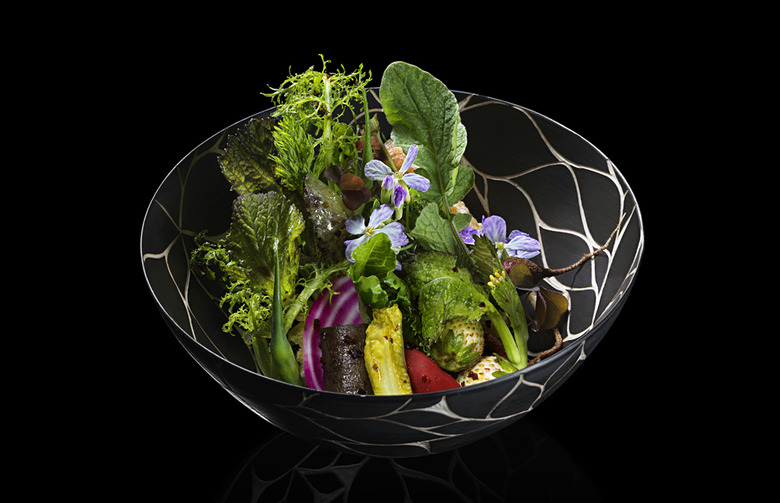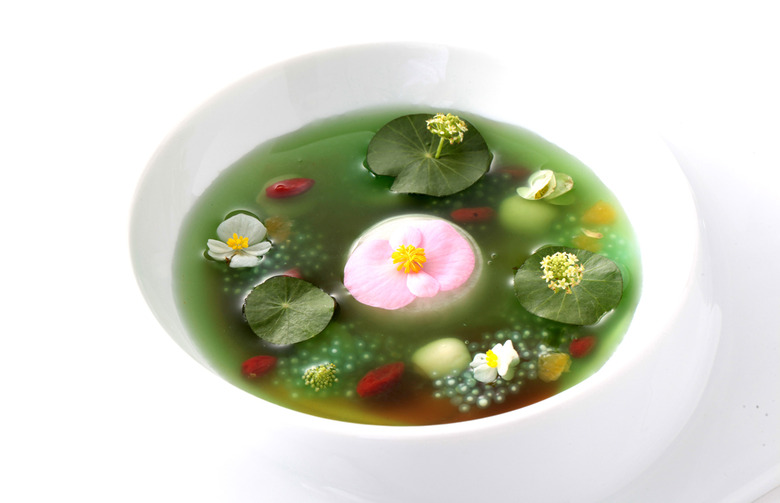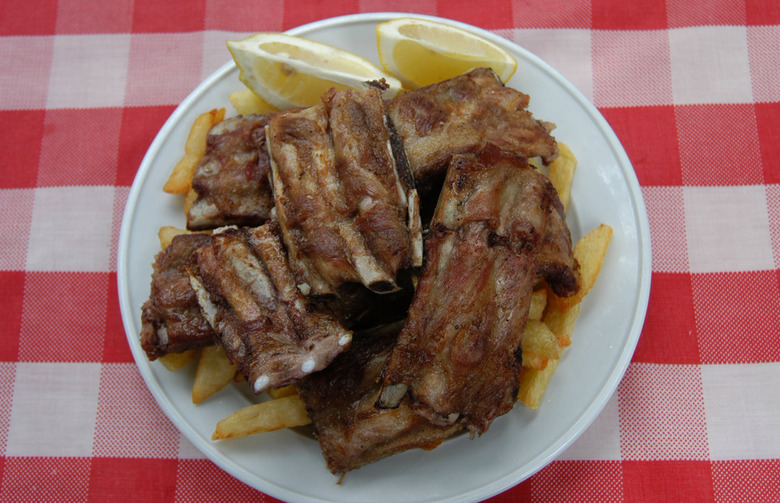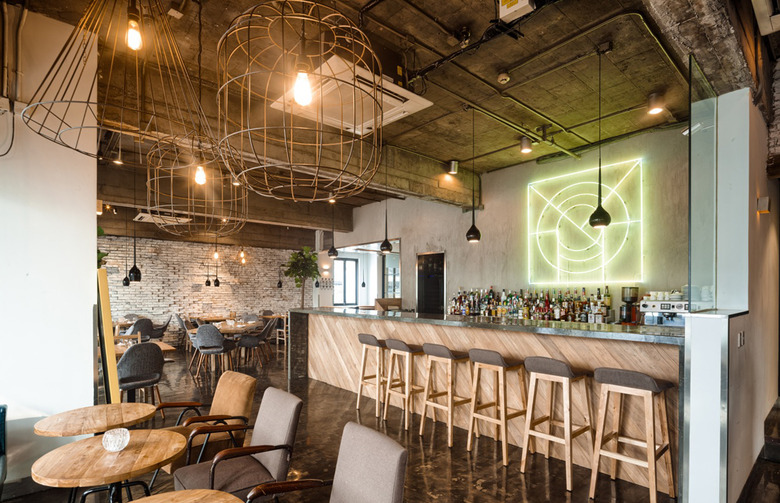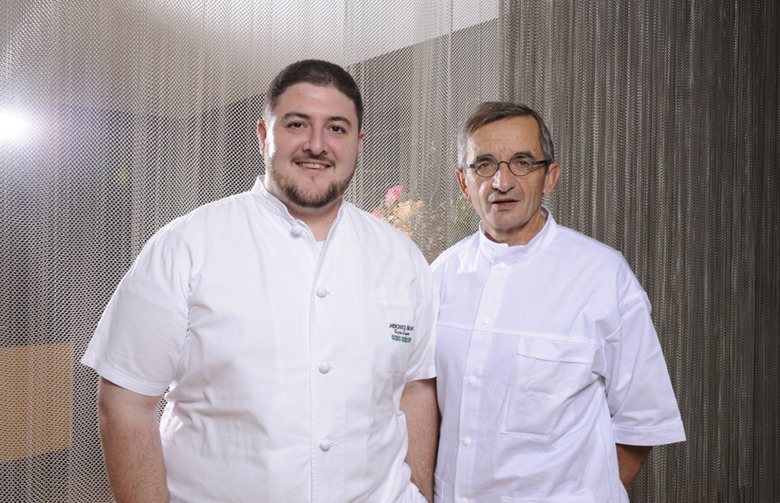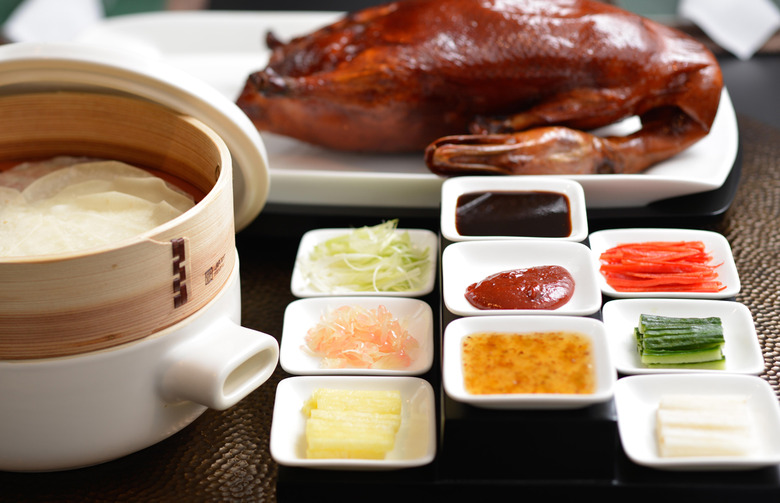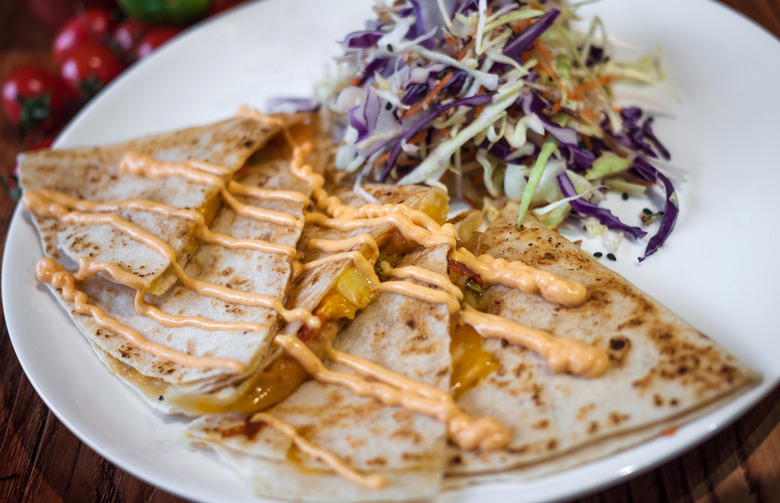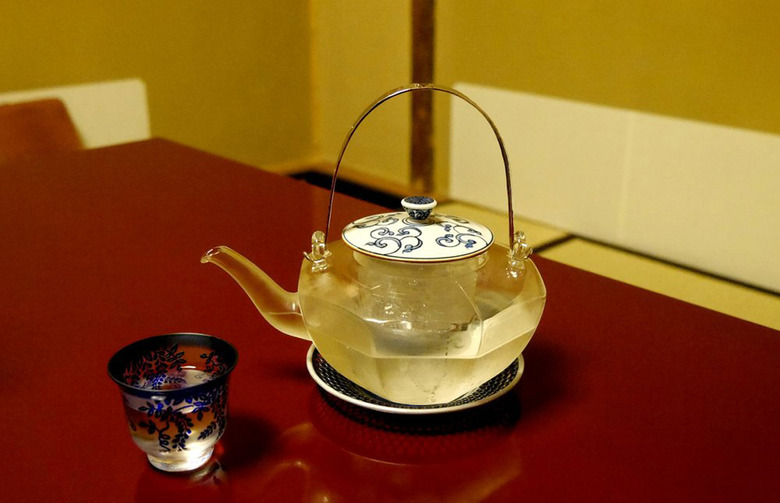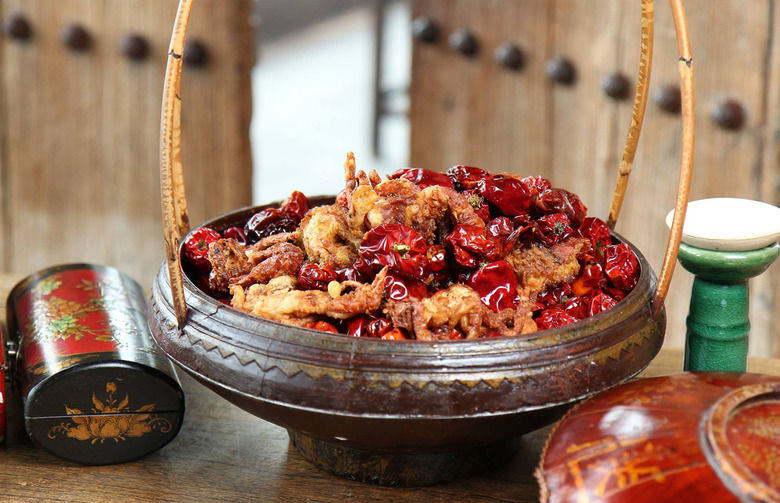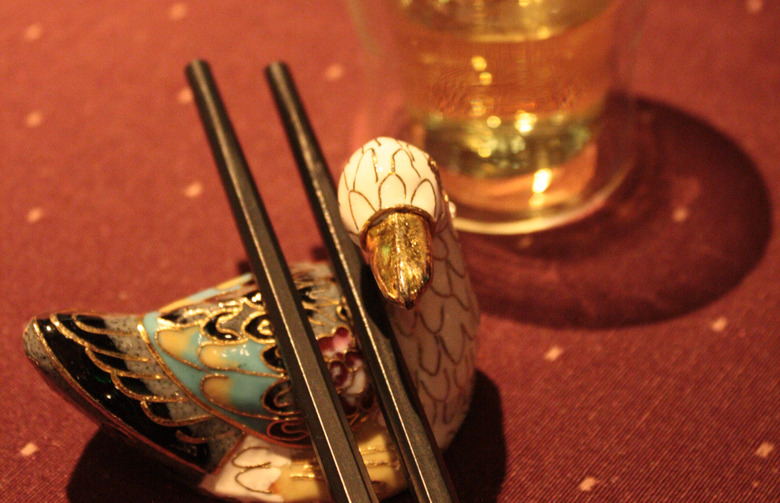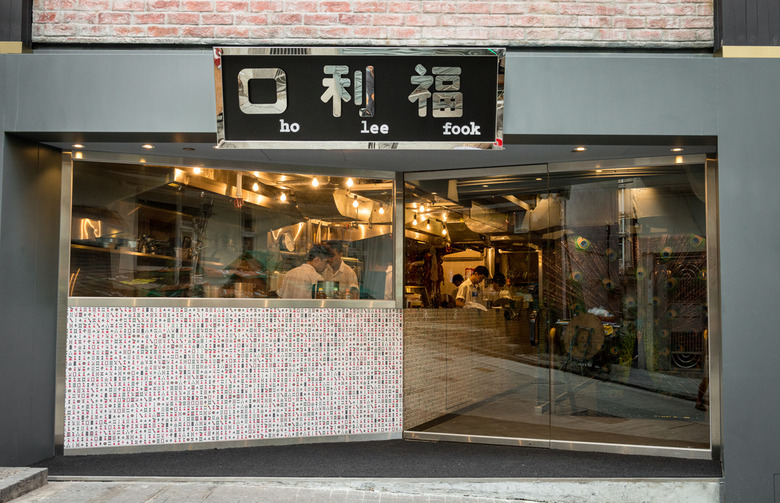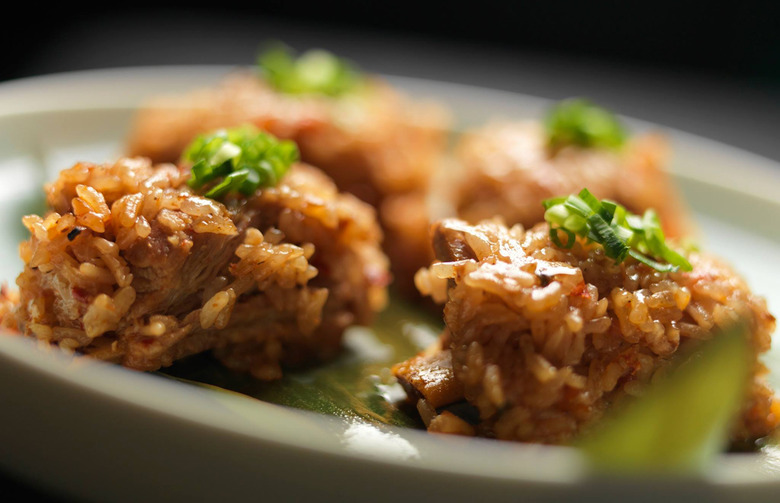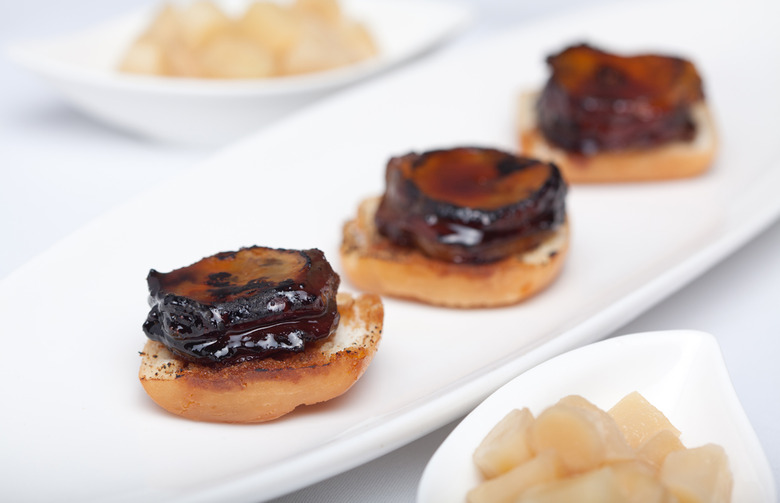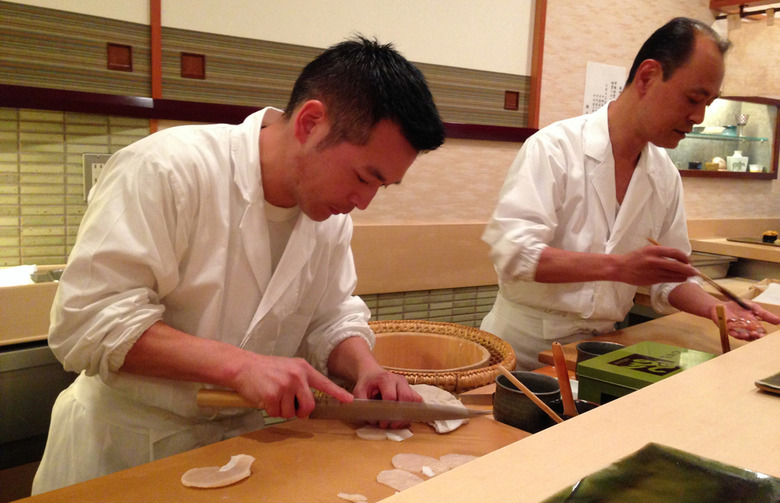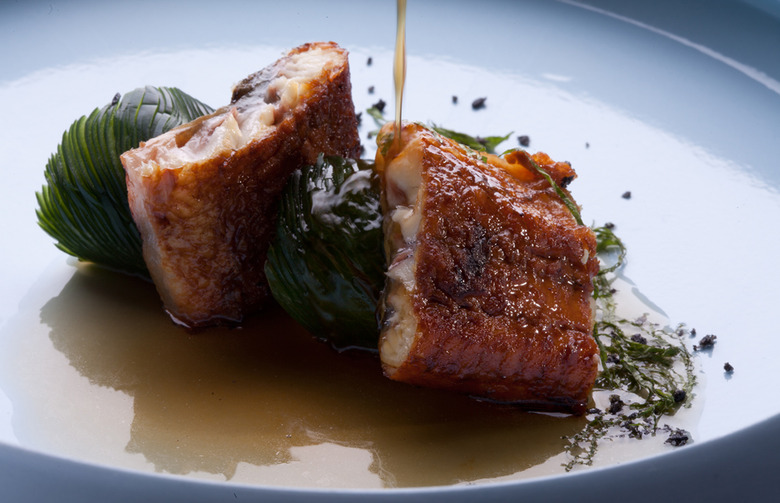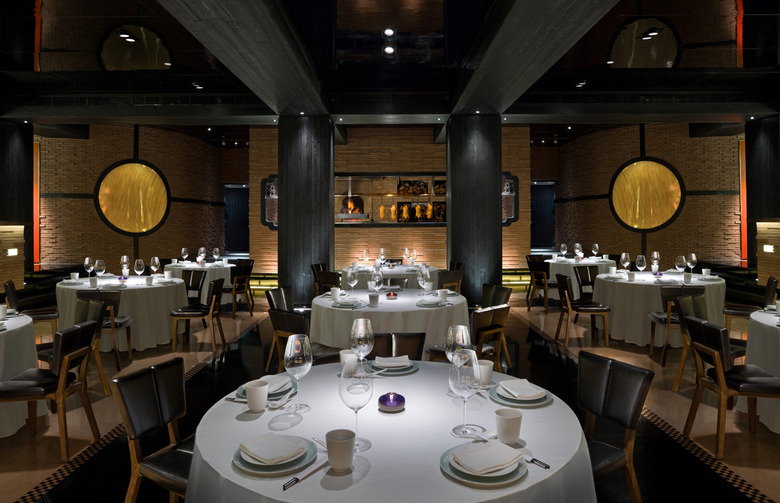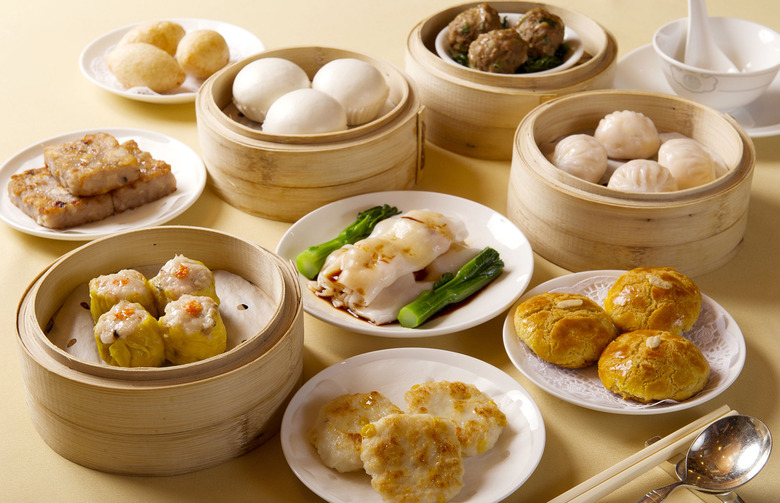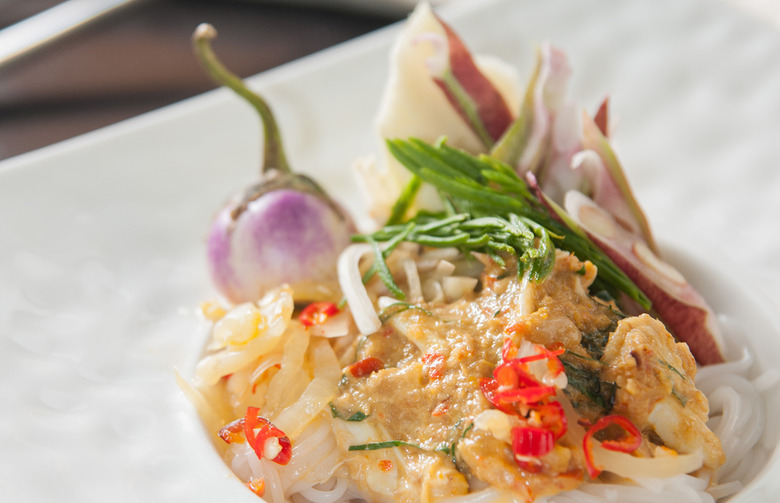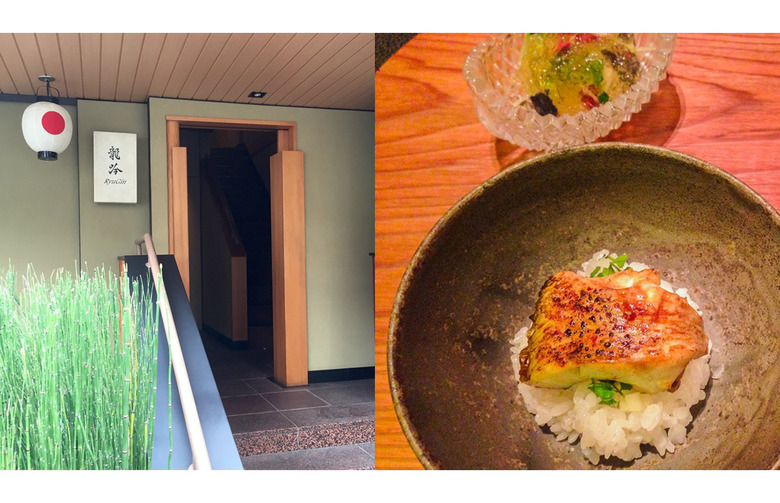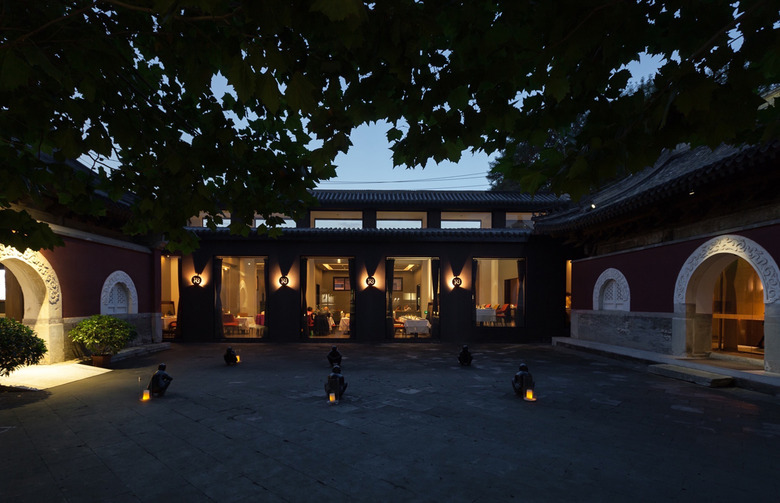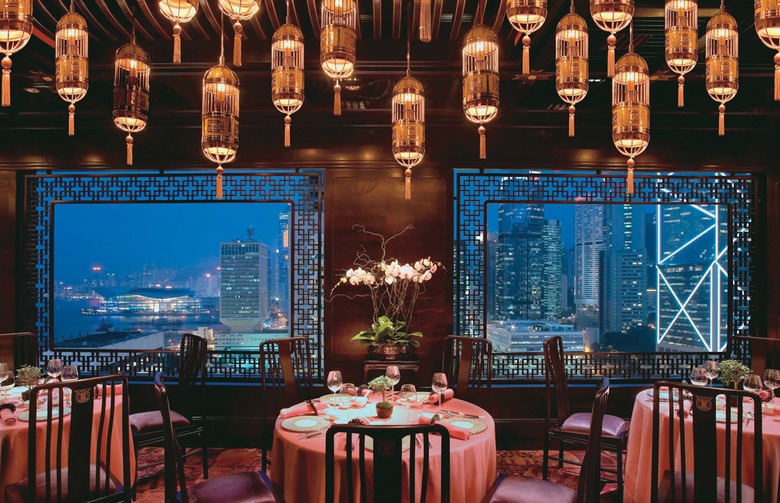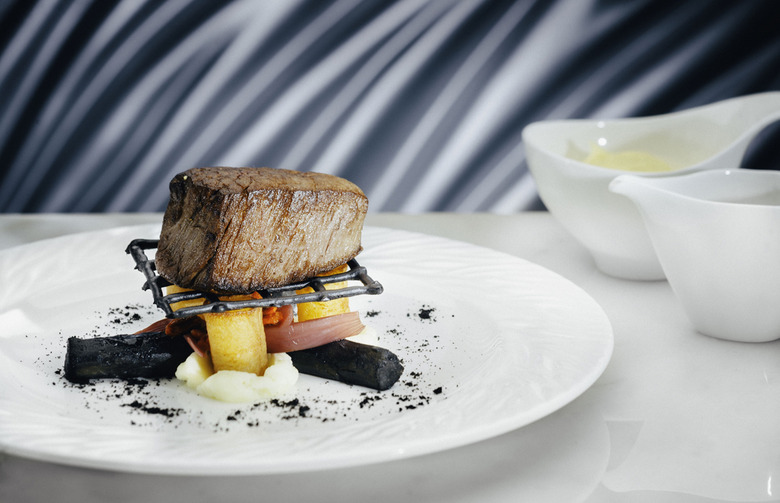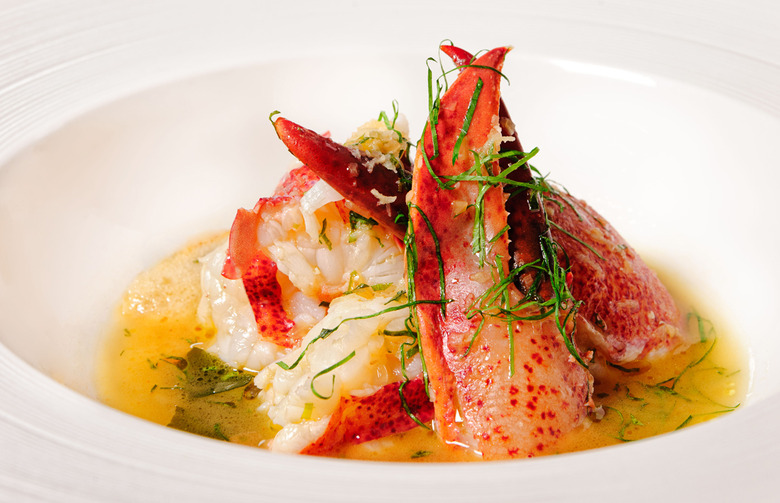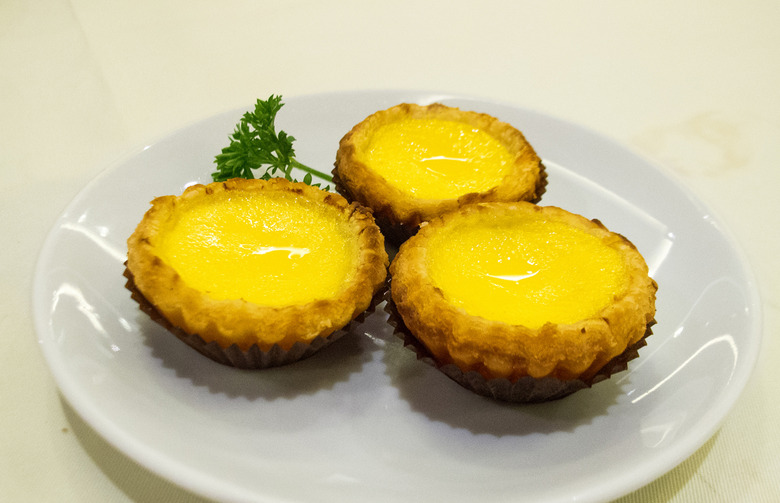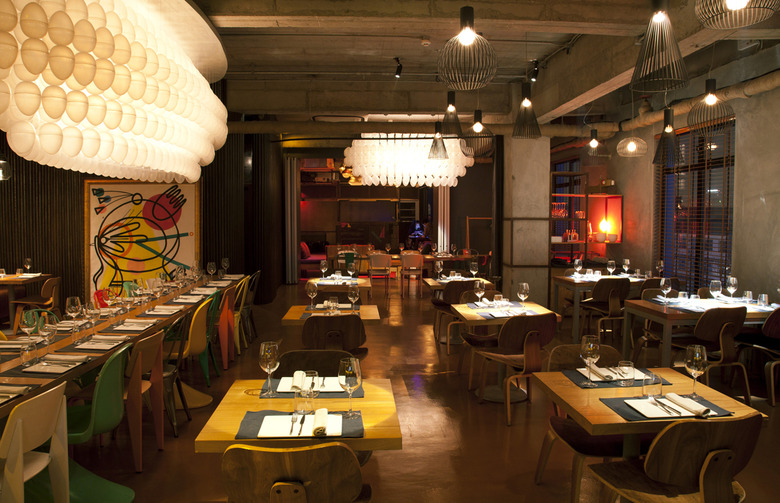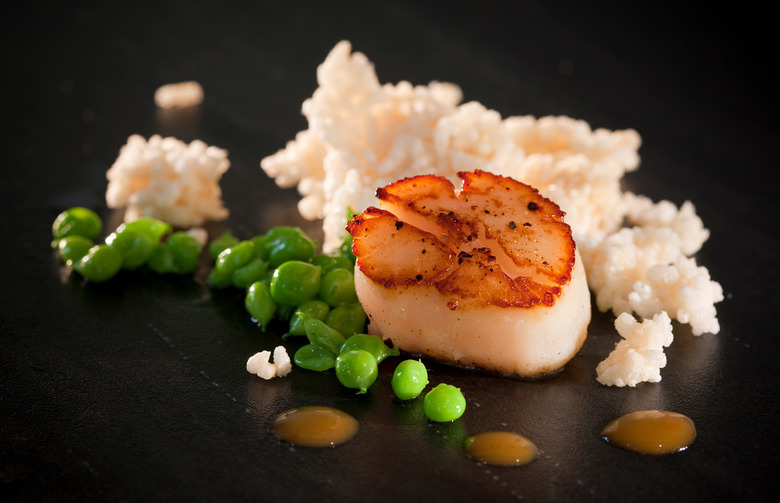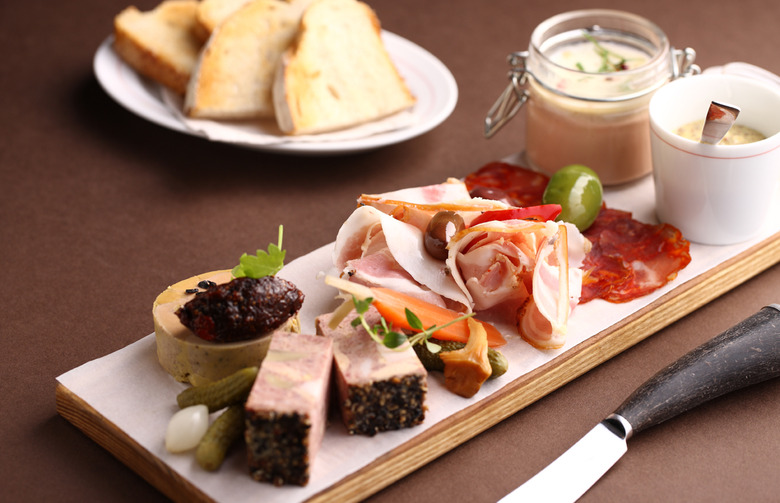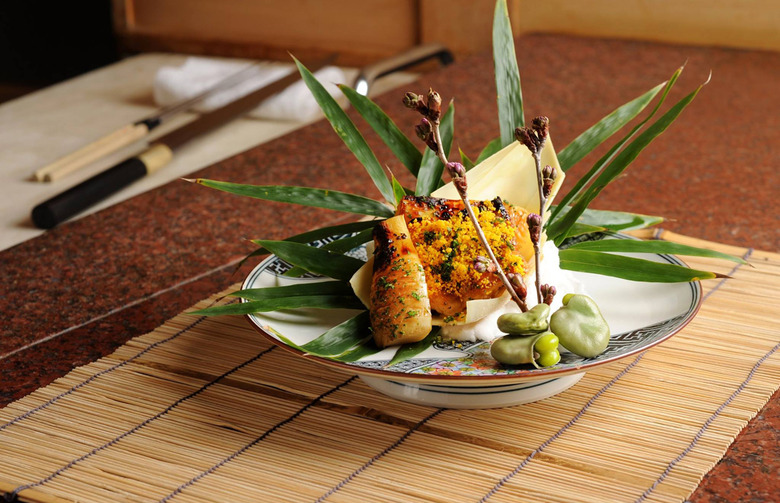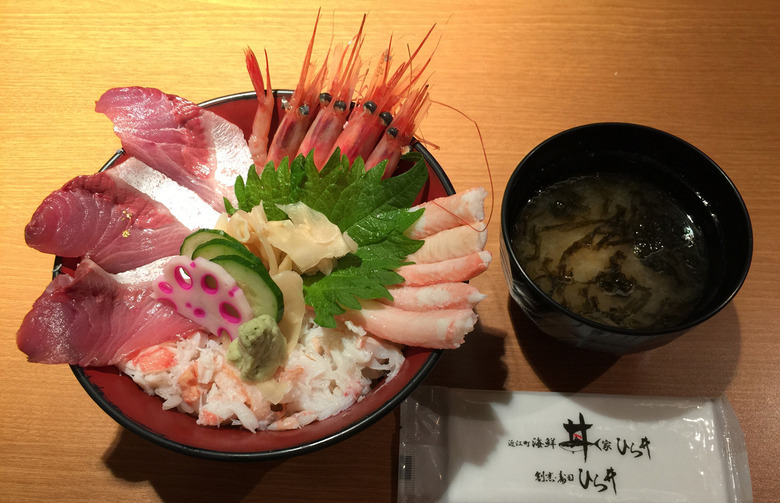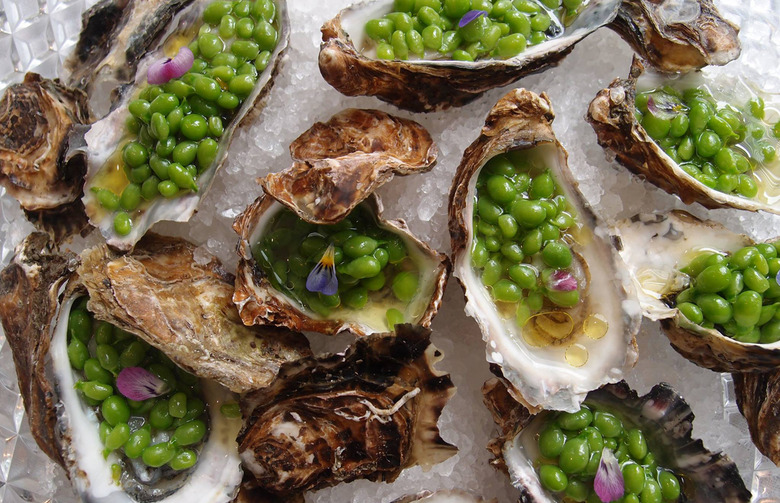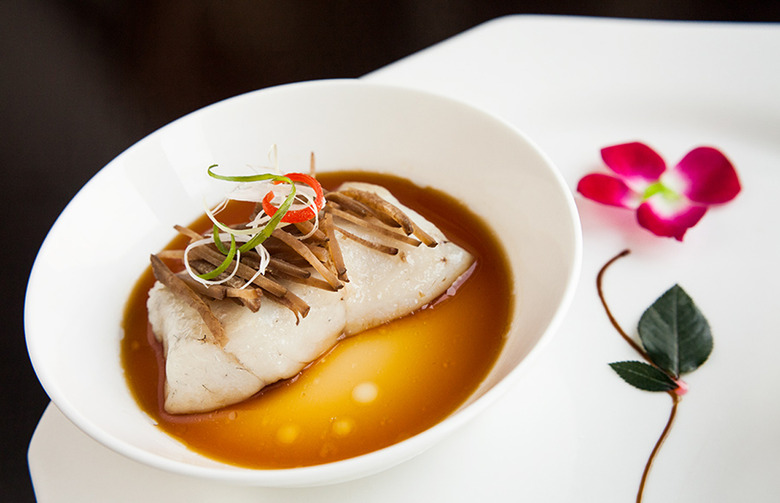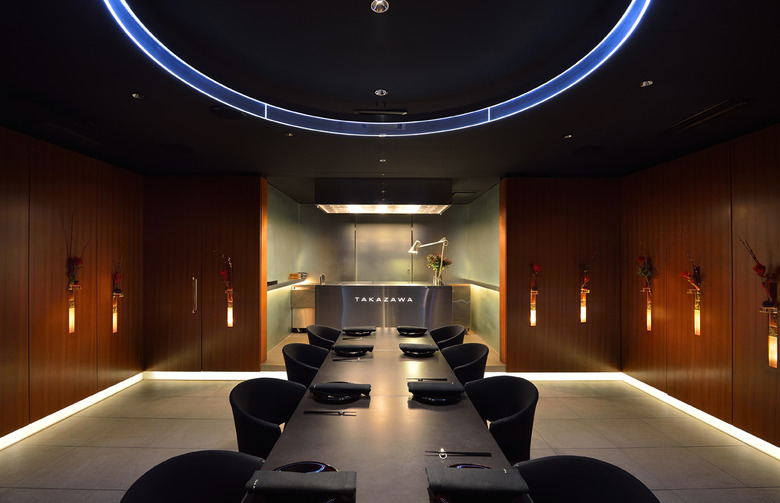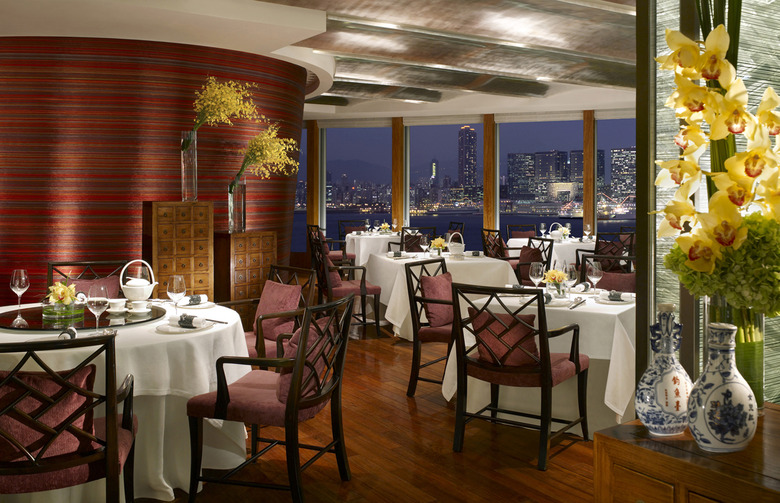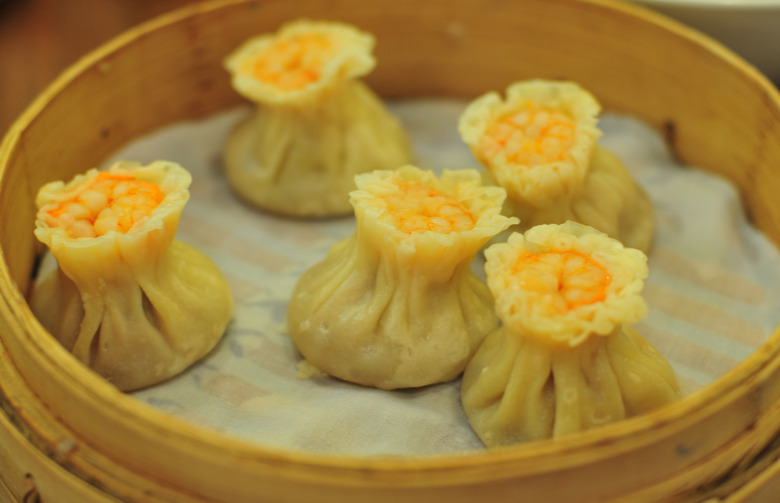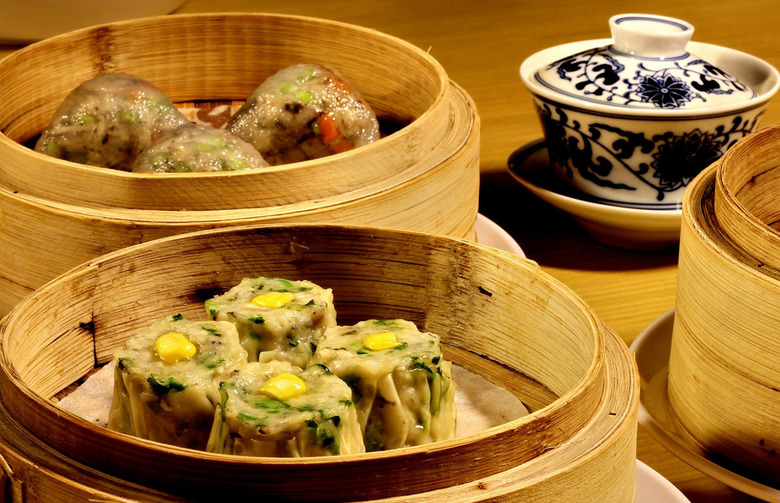101 Best Restaurants In Asia For 2015 Slideshow
Much can happen in a region's dining scene over the course of a year, and 2015 was no exception in Asia. Building on The Daily Meal's 2013 and 2014 lists of 101 Best Restaurants in Asia, we now present our third annual list, which is brimming with newcomers, long-time favorites, and favorite oldies that are new to our list.
101. Kingfisher (Unawatuna, Sri Lanka)
An ideal seaside destination, this simple, teak-filled, Indian Ocean-front restaurant serves sublime seafood like lobster, arrack-lime prawns, and tuna steak. Chef Duminda Roshan Matarage's à la carte menu includes Thai curries and fresh seafood straight from the surrounding waters. Dine on the edge of the beach, with great views, great music, and great cocktails to enhance the experience. This season, the restaurant will open a new Lounge Beach Bar, enhancing the Kingfisher experience.
100. HVN (Colombo, Sri Lanka)
Located in Casa Colombo, a 12-suite hotel boutique in this island nation's largest city, HVN is a retro-trendy restaurant. Tucked into a 200-year-old Moorish mansion replete with Italian and Indian mosaic floors, molded ceilings, and vintage charm, HVN was the former grand hall of the mansion and has been transformed into a posh restaurant with gold carved ceilings, an antique 18-foot fan, glass organza tables, and a fresco of the sage Rishis meditating in the clouds. The eclectic fusion menu features dishes seldom seen in these parts: Sri Lankan mild curry prawn bisque with cheese toast; shredded roast beef on Gotukola mango salad with tamarind dressing; arrack-flamed jumbo prawns with chile-lime pickle and garlic rice; and soft Godamba roti rolls filled with chile-salt caramel, cashews, and vanilla ice cream.
99. Mejekawi by KU DE TA (Bali)
Mejekawi is a tasting kitchen and laboratory by the culinary team behind a popular Balinese establishment at the same address called KU DE TA — executive chef Ben Cross, head chef Stephen Moore, and executive pastry chef Nuño Garcia, overseen by famed American pastry chef Will Goldfarb, now living in Bali. The five- and 12-course degustation menus at the sleek, glass-walled Mejekawi, whose name may be loosely translated as "sacred table," might include such dishes as wood-fired freshwater crayfish with XO sauce, fregola, and spring onions; black cod cooked over coals with roasted chile paste, jicama, apple, and lime; and Thai basil sorbet with cucumber granité, homemade milk curd, and strawberries.
98. Bale Dutung (Pampanga, Philippines)
Tucked inside chef Claude Tayag's home, Bale Dutung welcomes diners by reservation only. Consistently positioned on top restaurant lists and praised by the likes of Anthony Bourdain, Bale Dutung serves Filipino cuisine in an old-school house decorated with antiques and a gallery of the chef's art. The restaurant specializes in Kapampangan dishes prepared from scratch, but Tavag adds a twist to old family recipes and his wife shares a little history and background on each dish as it is presented to guests. Signature dishes include kare-kare dagat (seafood in peanut sauce); lechón (roast whole pig); pako (fiddlehead fern) salad in honey with calamansi-mango dressing; and adobong pugo (stewed quail). Save room for the Paradiso, a dessert consisting of yam balls, dessert, three balls of ube yam, macapuno (a special type of coconut), and yema (egg yolk candy) in buffalo milk crème brûlée.
97. Don’s (Hanoi)
With its breathtaking view of Hanoi's West Lake and its smorgasbord of carefully crafted comfort dishes — from fresh-shucked oysters, wood-fired sourdough pizzas, and risottos and fresh pastas to Vietnamese classics — Don's is the place for excellent but no-fuss, no-ego dining. Chef Don Berger shows his love for travel in his extensive global menu, for which he carefully sources ingredients both internationally and locally. Think smoke-y charcoal-grilled Japanese Kobe & USDA prime steaks cut to order; lotus-blossom-tea-smoked salmon; fettuccine carbonara with imported pancetta; and incredible desserts, like Don's tiramisù marou and chocolate and passionfruit crème brûlée. The traditional Vietnamese fare includes Hanoi beef phở; cashew-crusted squid paste on sugar cane; and bánh xèo, a crisp egg pancake with shrimp and pork. There is a great lineup of live music nightly in the Oyster Bar, where diners can enjoy a world class wine list, a Cuban cigar, and array of signature cocktails, or the coldest Sapporo draft beer in town.
96. Baekdu (Busan, South Korea)
There's no need to peruse the menu at Baekdu as it only serves two versions of han-jeongsik, a lavish set menu that includes cold appetizers; main dishes that are grilled, steamed, or fried; and many, many savory banchan (side dishes). Popular with students from nearby Kyungsung University and with local families, Baekdu's set menus provide so much food that you'll want to come with a crowd.
95. Fatty Crab (Hong Kong)
A daring Asian branch of New York City's original Fatty Crab, this lively restaurant offers a carefully curated American take on Asian cuisine, with "a little southern BBQ in the mix." The menu is updated regularly and includes staples like market oysters and the restaurant's famous chili crab along with new items including smoked salmon tartar with Thai chiles and lime served with shrimp chips; red coconut curry lamb served with roti canai; and a "laab moo" Scotch egg. The restaurant has a layout consisting of multiple rooms, a raw bar, and a separate bar for drinking that has recently been re-branded as The Pontiac, a cross between a rock-n-roll dive bar and a suave cocktail bar. Customers enter Fatty Crab either through The Pontiac or through the secret back alley entrance.
94. GREEN T. HOUSE (Beijing)
This ultramodern retreat, now relocated to Beijing's villa district, is owned by JinR, a Beijing musician, designer, music, and tea connoisseur. In the 15,000-square-foot space, which includes a "residential bath" palace, gorgeous gardens, and white peddled courtyards, guests experience dining in a new way, eating in a 900-square-foot, 25-seat ultramodern space that's guaranteed to wow the first-timer. But lest you think this is just another hip tea shop, GREEN T. HOUSE serves excellent seasonal "Modern China T. Cuisine," which includes many dishes incorporating tea. Among these are favorites from previous GREEN T. HOUSE establishments, like "Field Dreams" (fresh pear slices with homemade honey mustard, toasted walnut,s and pecans, topped with goat cheese) and "Naughty Little Fennel Dumplings" to "Wasabi Prawns Dancing to a Mango Salsa" and "Curly Chicken," with Sichuan pepper, sesame, and Parmesan on a bed of Woolong tea leaves.
93. Ka Jok See (Phuket, Thailand)
Ka Jok See (which means "stained glass window") avoids the limelight, not advertising its presence but relying on its exceptional food and word of mouth to build its clientele. Nestled in a Sino-Portuguese house on a quiet street, owner Khun Lek's restaurant is packed every night (reservations are essential). Diners pay one price for all-they-can-eat off a small menu of mostly Thai cuisine (fried spring rolls, shrimp with thin noodles, chicken in lemon sauce, etc.). There's music, too, and the night usually ends with dancing between (and sometimes on) the tables.
92. Ziya at The Oberoi Mumbai (Mumbai)
Ziya has been a pioneer in modern Indian cuisine in India. Locals and visitors alike clamor for reservations in a dining room that offers sweeping views of the ocean and Mumbai's skyline. Run under the guidance of Vineet Bhatia, whose restaurants in London and Geneva are Michelin-starred, the restaurant offers such signature dishes as Subz potli (a flaky pastry bag of chile-pickled vegetables, rajma rice, and chickpea-based Punjabi kadhi sauce); grilled ginger-chile lobster with spiced lobster jus, curry leaf-broccoli khichdi [lentils and rice], and spiced cocoa powder) ; and Matka chicken (a whole chicken braised in a pot, with masala-chile rice, and kachumber [chopped salad] raita).
91. T'ang Court at The Langham, Hong Kong (Hong Kong)
Two Michelin star T'ang Court has long been regarded as one of Hong Kong's finest Cantonese restaurants. The restaurant serves up a repertoire of time-tested classics featured on à la carte and set menus in the comfort of a resplendent dining room clad in red and gold silk and adorned with contemporary sculptures. The restaurant's five private dining rooms are all named after Tang Dynasty poets—Tai Bai, Le Tian, Zi Shou, Bai Yu and Zi Mei. Chef Kwong Wai Keung's signature dishes include stir-fried fresh lobster with spring onions, red onions, and shallots; sautéed prawns and crab roe accompanied by golden-fried pork and crab meat puffs; and baked seafood rice with cream sauce served in a crab shell.
90. Sir Elly's at The Peninsula Shanghai (Shanghai)
Located on the 13th floor of the high-end Peninsula Shanghai hotel, Sir Elly's is a glamorous fine-dining establishment offering modern European cuisine. Theculinary team headed by chef Terrence Crandall creates elegant servings of exciting dishes like pan-fried turbot with baby artichokes, celeriac purée,Ibérico ham, and chicken juice; whole roasted lamb rack for two, with lamb shank ravioli and wilted romaine; and grilled Australian Mayura full-blood Wagyu tomahawk steak. Sir Elly's also boasts an impressive list of over 400 wines, a gorgeous terrace, and possibly the city's best view of the Bund and the Pudong skyline.Located on the 13th floor of the high-end Peninsula Shanghai hotel, Sir Elly's is a glamorous fine-dining establishment offering modern European cuisine. Theculinary team headed by chef Terrence Crandall creates elegant servings of exciting dishes like pan-fried turbot with baby artichokes, celeriac purée,Ibérico ham, and chicken juice; whole roasted lamb rack for two, with lamb shank ravioli and wilted romaine; and grilled Australian Mayura full-blood Wagyu tomahawk steak. Sir Elly's also boasts an impressive list of over 400 wines, a gorgeous terrace, and possibly the city's best view of the Bund and the Pudong skyline.
89. A Lorcha (Macau)
The casual A Lorcha ("the wooden ship") makes its debut on our list for its exceptional Portuguese fare, including clams "Lorcha style" with tomato, beer, and garlic. Don't miss the seafood paella, Brazilian feijoada, or classic roast chicken, all served in a cozy, colonial-style dining room that is perennially packed with locals and visitors alike.
88. The QUBE (New Delhi)
Named for its shape, The QUBE is a box of sparkle: reflective charcoal floors, mother-of-pearl panels, floor-to-ceiling glass walls overlooking lush gardens, silver urns brimming with 2,600 fresh roses replenished daily, and a floating lit ceiling of suspended metal dishes that change color above serve as the backdrop for a memorable meal. Chef Ashmeet Jolly prepares globe-trotting grand buffets (guests will never see the same dish twice), a stellar à la carte menu, and seasonal set menus. Favorites here include the Thai pla nuam seabass; Italian basil and tomato paccheri; Indian lamb rogan gosh; and the chef's famed breakfast dish, a whipped masala-eggwhite omelette with arugula.
87. Monsoon Restaurant & Bar Saigon (Ho Chi Minh City)
Monsoon Restaurant & Bar was first established in Yangon, Myanmar, turning out memorable dishes from Cambodia, Laos, Myanmar, Thailand, and Vietnam. The restaurant has expanded to Ho Chi Minh City — which everybody still calls Saigon — where its signature dishes—like Thai tom yum goong (a clear spicy and sour soup); Burmese mohinga (a rice-noodle and fish soup); and Vietnamese phở — are as good and as popular as ever.
86. Le Malraux (Siem Reap, Cambodia)
Located in the Old Market in Siem Reap, the brasserie Le Malraux — named for the late French novelist and onetime Minister of Cultural Affairs who visited Cambodia and wrote about it in the 1920s — is a cozy spot from which to escape the hustle and bustle of the city. Grab a seat on the terrace and indulge in Khmer specialties like fish amok (curried fish steamed in banana leaves) and stir-fried beef Lok Lak.
85. Kualao (Vientiane, Laos)
In a humble French colonial villa in the Laotian capital, 16 chefs and kitchen assistants follow timeless recipes to craft authentic Lao food served in a traditional southeast Asian dining room furnished with rattan, patterned textiles, and elegant tableware. Hostesses dressed in traditional Lao sinh skirts greet guests and waiters in black trousers, white shirts, and bow ties provide impeccable table service to state officials, celebrities, diplomats, locals, and tourists alike. The best way to sample Kualao's most famous dishes — including papaya salad with tomatoes and fish sauce; homemade sour pork sausages; and steamed Mekong fish with local herbs wrapped in a banana leaf — is by ordering the pakao (set menu).
84. Soul Food Mahanakorn (Bangkok)
Soul Food Mahanakorn promises "Wholesome ingredients, honest cooking, serious drinks." What more could the diner ask? The restaurant basically brings street food into a comfortable setting, offering such delights as smoky grilled Isaan chicken wings; tiger prawn satay; crispy morning glory salad; khao soi (a classic northern Thai soupy noodle dish), and smoked duck larb, in a warmly lit wood-paneled dining room, with a comfortable bar.
83. Quan Ngon 138 (Ho Chi Minh City)
Nestled in a traditional Hué-style wooden house, Quan Ngon 138 brings the distinct tastes of northern, middle and southern Vietnam together under one roof. The food here is made in and sold from separate stalls, a throwback to the days when food was sold by street hawkers across the country. Executive head chef Thu Truong leads a team of 30 who prepare a staggering menu of 300 traditional Vietnamese dishes in the kitchen and at various food stalls in the dining room. Unlike many restaurants that offer an extensive menu of mediocre fare, everything here is made fresh and expertly, much of it in front of diners. Try the Hai Phong sea-crab square spring rolls (fried square spring rolls stuffed with crabmeat, mushroom, vermicelli, and minced pork) and dry steamed chicken in clay pot (a southern Vietnamese delicacy of a whole chicken cooked in a giant clay pot that heats the bird from four directions, yielding perfectly crisp and golden chicken skin encasing juicy meat), served with crispy sticky rice cakes.
82. Fat Siu Lao (Macau)
Fat Siu Lau is one of the oldest restaurants in Macau, founded by Wong Man Sing more than 100 years ago. The third and fourth generations of his family still serve the restaurant's signature dish: roast pigeon from Shek Ki marinated with a family recipe that has been kept a closely guarded secret since 1903. While the original two-story restaurant has long been closed (it relocated to Macau's former red light district), folks still line up on cobbled Rua da Felicidade for a seat in the cozy dining room for the famous pigeon and other Portuguese Macanese delights as "curry crab and "African chicken." The legendary dining continues with two new branches: Fat Siu Lau 2 in Macau's bar street area and Fat Siu Lau 3 on Rua de Regedor in Taipa village.
81. Wild Rocket (Singapore)
Nestled in the quiet enclave of Mt. Emily Park, Wild Rocket occupies a space modeled after a traditional Japanese chashitsu (teahouse), complete with a rock garden path flanked by textured paper that welcomes guests into three areas: the main à la carte section; a long concrete counter for omakase patrons where award-winning chef Willin Low regularly serves guests personally; and a recessed area used for private dinning. From the ceiling to the walls and onto the exterior façade is an amazing wooden carapace made up of 15,000 meranti wood batons, both an art installation and a sunshade. The not-to-be-missed cuisine, which the chef has dubbed "Mod-Sin" (short for Modern Singaporean), includes a duo of starters: pomelo salad with tiger prawns and frozen coconut dressing and "roast-chicken-rice" wings; pastas llke laksa pesto linguini with king prawn and quail egg and Singapore fried noodles with king prawn Hokkien mee; mains including a 48-hour beef short rib rending and roast Chilean sea bass with chai poh (preserved turnip) confit and congee; and desserts such as Wild Rocket strawberry cheesecake and pandan-infused panna cotta with salted gula melaka (coconut sugar).
80. Agua (Beijing)
The intimate and chic Agua — which, confusingly, is part of the Aqua, with a "q," restaurant group — has been a local favorite in Beijing for years. Chef Jordi Valles crafts classic and contemporary Spanish tapas and more serious cuisine as well. Not to be missed are his 50-month Monsalud jamón ibérico; contemporary tapas like cucumber canelloni stuffed with Spanish tuna, apple, tomato, shallots, ponzu sauce and hazelnuts; and classic tapas like ham and mushroom croquettes and patatas bravas. Don't overlook the non-tapas offerings, though. Mains like seared Argentinean calamari served with black olives and tomato soffrito in squid ink aïoli and grilled beer-and-mustard-marinated pork belly with vegetables en escabeche and pumpkin purée are pure perfection.
79. JB Ah Meng Kitchen (Singapore)
Off a somewhat sketchy Geyland back alley, JB Ah Meng Kitchen is one of Singapore's best home-style Chinese restaurants, serving famous white pepper crab; deep-fried eggplant with bell peppers; stir-fried san lou bee hoon noodles tossed with shrimp, squid, and egg; and an extraordinary dish of fresh prawns in corn-kernel batter, glazed with salted egg sauce — a dish so compelling that no less than Ferran Adrià reportedly once asked for the recipe.
78. Sawada (Tokyo)
Sawada is a six-seat husband-and-wife-run Ginza sushi restaurant offering an impeccable omakase menu and an intimate dining experience. At this Michelin two-star establishment, chef Koji Sawada prepares a three-hour-long feast that offers some of the finest seasonal wild seafood from all over Japan, some of it cured or lightly torched, and seasoned with the chef's own soy sauce blend or sprinkle of sea salt. David Chang has called this his favorite sushi bar in the world, and it's easy to see why.
77. Mizuno (Osaka)
With waits of an hour or more, it is clear that Mizuno has gained a reputation as one of Osaka's (and the world's) best places to get okonomiyaki. This classic Japanese treat, often described as "Japanese pizza," is in fact a savory pancake cooked on a teppanyaki grill, stacked with layers of ingredients like cabbage, udon noodles, fried egg, corn, and cheese, all drizzled with tangy sauce and sprinkled with fish flakes. At Mizuno, making okonomiyaki is a family affair, and has been for over 65 years. All the ingredients used for the pancakes are locally sourced. The yam flour pancake with roasted pork and scallops is a customer favorite.
76. Amber at The Landmark Mandarin Oriental Hong Kong (Hong Kong)
Housed in one of the most luxurious of all the many luxurious hotels in the former Crown Colony, this award-winning establishment (two Michelin stars, 38th place on the S. Pellegrino World's 50 Best Restaurants list) serves contemporary French cuisine as envisioned by Dutch-born chef Richard Ekkebus. The menu, which changes every three months, features influences of the restaurant's Hong Kong setting (sea urchin with lobster jelly, cauliflower, caviar, and crispy seaweed waffle), the Mediterranean (red tilefish with fennel and orange confit, bottarga, new potatoes, "bouillabaisse," and Manni olive oil emulsion), and the international culinary scene (blue lobster tail roasted with lemon verbena, with cooked and raw yellow peaches, pan-fried duck foie gras, and lobster claw ceviche.
75. L'Atelier de Joël Robuchon (Hong Kong)
Though legendary French chef Joël Robuchon credits a tapas bar in Alicante, for inspiring his counter-service L'Atelier format, the first example of this now international chain opened in Tokyo in 2003, a few months before his first Parisian version was launched — and the resemblance of the place to a sushi bar cannot be ignored. He now has L'Ateliers around the world. They're all good, but this Hong Kong hot spot is the only one with three Michelin stars. The format is basically modern (and sometimes classic) French cuisine served in delicate portion, from roasted Australian rock lobster with French green pea and Château Chalon sauce to sea urchin with lobster jelly, topped with cauliflower cream — all superb.
74. Endo Sushi (Osaka)
For more than a century, sushi aficionados have sought out Endo Sushi, tucked away on one side of Osaka Central Fish Market. Folks flock to the sushi shop as early as 4 a.m. to wait until its 5 a.m. opening, and the place stays crowded until it closes around 2 p.m. Most guests order the set five-piece seasonal sushi set, serving some of the freshest sushi you have ever had – guaranteed.
73. The Cathay Room at The Fairmont Peace Hotel (Shanghai)
The Cathay Room presents modern European home-style cuisine with a side of enviable views overlooking the Bund. The restaurant has long been popular with Shanghai high society, and remains a desirable destination, particularly if you can snag the one table for four on the Bund's only balcony, overlooking the Huangpu River and Shanghai skyline. Start with the braised and roasted pork belly with scallop-shallot crust and steamed silken tofu with squid ink jus; continue with mains like black cod and king prawn with braised cotechino sausage, red wine emulsion, green asparagus, and roasted mushrooms or oven-roasted Australian beef tenderloin with bourguignon morels, bone marrow, herb salad, and red wine jus; and finish with desserts like macerated cherries and dark chocolate with toffee ice cream and honeycomb coconut crumb or plums soaked in red wine with chocolate mousse and an almond tuile with yogurt ice cream.
72. S.T.A.Y. at Shangri-La Hotel Beijing (Beijing)
S.T.A.Y., the work of French chef Yannick Alléno, opened at Shangri-La Hotel, Beijing in 2011 and the local dining scene hasn't been the same since. S.T.A.Y., which stands for "Simple Table Alléno Yannick," serves the multi-Michelin-starred chef's signature reinterpretations of traditional French cuisine in a fun and interactive setting. Chef de cuisine Pierrick Maire runs the kitchen here, preparing such dishes as duck foie gras terrine with black olives and pickled carrots, poached langoustines with shellfish fricasée and pilaf rice, and black pepper Wagyu beef filet Café de Paris with potato purée. The restaurant also boasts Asia's first "pastry library," an invention of Yannick's, where diners can choose the final ingredients for their cakes, pastries, and tarts.
71. Opera BOMBANA (Beijing)
Three-Michelin-starred chef Umberto Bombana brought his signature cooking and restaurant philosophy from 8 1/2 Otto e Mezzo BOMBANA in Hong Kong (#15) to Beijing in the form of Opera BOMBANA in 2013. Here, executive chef Marino D'Antonia follows Bombana's lead, adding his own creative touch in the kitchen to turn out exemplary Italian set menus at lunch and mesmerizing à la carte and tasting menus at dinner. Signature standouts include homemade spaghetti alla chitarra; short rib and beef tenderloin with red wine and plum sauce and whipped potatoes; and warm lobster salad with fennel and celery root jelly and roasted shiitake mushrooms.
70. Bukhara at ITC Hotel Maurya (New Delhi)
Named one of S. Pellegrino World's 50 Best Restaurants, Bukhara is renowned for its robust Northwestern Frontier tandoori cuisine. The menu, unchanged for 35 years, features classics like marinated whole leg of lamb; succulent tandoor-cooked jumbo prawns; and the house naan, which measures almost four feet in diameter. But the most famous dish here might be the dal Bukhara, a rich black lentil version of this traditonal pulse dish, simmered over a slow fire for 18 hours. Bukhara has played host to such global VIPs as Barack Obama, Bill Clinton, Tony Blair, and Arnold Schwarzenegger, and continues to be an iconic destination on the itinerary of many visitors to New Delhi.
69. Jean Georges (Shanghai)
In the spirit of many of Jean-Georges Vongerichten's restaurants, executive chef Paul Eschbach here transforms French dishes with bold, Asian seasonings and unique flavor combinations. Jean Georges, a sumptuously appointed restaurant that offers views of the Bund, offers such starters as foie gras brûlé paired with pistachios and tart sour cherries; mains like grilled lamb chops with roasted Brussels sprouts and pistachio pesto; and desserts such as the signature Jean-Georges molten chocolate cake with house-made vanilla ice cream.
68. Robuchon au Dôme (Macau)
Originally Robuchon a Galera, Robuchon au Dôme was renamed after being relocated to the 780-foot-high dome of the Grand Lisboa Hotel. With a breathtaking view, dramatic décor built around a colossal chandelier of 131,500 pieces of Swarovski crystals, and top-notch French cuisine, the restaurant, graced with three Michelin stars for the past seven years, provides an exquisite fine-dining experience. The wine list is the most extensive in Asia, with more than 15,700 labels. Menu highlights from Joël Robuchon, the world's most Michelin-starred chef, include Le Caviar (caviar jelly with cauliflower cream, "surprise of caviar in fine coral infusion with cream of peas," and a crunchy cone stuffed with avocado salsa and lime zest); L'Œuf de Poule (warm soft boiled egg with baby spinach purée and aged Comté cheese mousse); and La Pièce de Bœuf "Kagoshima" (pan-seared Kagoshima beef with green asparagus, black truffles, and soufflé potatoes).
67. Ultraviolet by Paul Pairet (Shanghai)
French chef Paul Pairet offers a globe-trotting, highly experimental 20-course set menu with sides of multi-sensorial technologies at Ultraviolet. The very location of the restaurant has been kept secret; diners who make advanced reservations (only 10 people are allowed each night and the waiting list is often three months long or more) are given a meeting spot where they are picked up by restaurant staff and seated at a single table situated in a dining room devoid of décor. Instead, the Spartan white-walled chamber is tricked out with LED floor strips, pin projectors, infrared cameras, and dry scent diffusors; each course comes accompanied by complementary lights, sounds, music, scents, and visual effects. Dishes begin in bite-sized portions and get progressively bigger, like a culinary crescendo, before shifting to digestifs and sweets of diminishing sizes.
66. Sushi Saito (Tokyo)
Despite moving from its parking garage location in Akasaka to the first floor of Ark Hills in Roppongi, Sushi Saito is still a small affair, with only eight seats at a wooden counter (there is a private room too) and three-Michelin-starred chef Takaashi Saito works just as hard as he ever did to maintain his award-winning sushi perfection. If you get a seat at this reservations-only place, you'll enjoy everything, but above all, sample the three tunas: lean akami, medium-fatty chu-toro, and the much-prized, well-marbled o-toro.
65. Byeokje Galbi (Seoul)
Like most of the best restaurants in Seoul, Byeokje Galbi specializes in one dish: in this case, beef ribs, served with a collection of side dishes including cabbage salad, roasted garlic, cold glazed sweet potatoes, kimchi, rice, green beans, pickled cabbage, onion with chiles, and soup. The tender beef is grilled over coals and melts in the mouth, much like Japan's Kobe — though the meat, in fact, comes from cows raised on a Pocheon farm under the direct management of the restaurant. Another dish on the small menu, bulgogi (marinated beef), cooked at the table on a domed copper grill and served with green onions, enoki mushrooms, cold glazed sweet potatoes, kimchi, and pickled cabbage, is also worth a try.
64. Rural Kitchen of Liliw Laguna (Manila)
The entirety of this 14-table restaurant — food, design, branding — is an ode to chef Justin Sarabia's lola (grandmother). Nearly all of the dishes on the menu are from her recipes and nearly all of the ingredients are sourced from the chef's hometown of Liliw, about two hours away from Manila. "I think what has resonated so well with people — aside from the food — is that we strive to keep the story and what we do as close to the heart as we can," said Sarabia, who stirred stock at a ramen shop in TriBeCa and grilled lobster for April Bloomfield before opening Rural Kitchen of Liliw Laguna. Don't miss the pork adobo (deep fried pork marinated in the restaurant's own vinegar); beef Mechado (beef stewed in sweet tomato sauce); and pako salad (a light salad of fiddlehead ferns and calamansi, a citrus fruit).
63. Candlenut(Singapore)
The modern Candlenut is a treasure, preserving the legacy of Peranakan (Chinese-Malay or Straits Chinese) culture and cuisine, which is already a rare and disappearing heritage, in the comfort of a dining room furnished with dark wood, potted orchids, and framed Peranakan artwork. Here Peranakan dishes are elevated with contemporary techniques for an à la carte lunch menu and a weekly changing dinner tasting menu heavy on shellfish and pork. Chef Malcolm Lee's long-cooked Wagyu beef buah keluak and also his buah keluak ice cream (buah keluak is a poisonous fruit made edible by fermentation) are not to be missed.
62. RAW (Taipei, Taiwan)
RAW is the pioneer in Taiwan of so-called "Bistronomy," the French concept of fine dining served at an affordable price in an informal relaxing setting, RAW's menu is playful and creative in a straightforward way. Star Singapore chef-restaurateur André Chiang (a native of Taiwan) teamed up with chefs Alain Huang and Zor Tan to create a seasonally changing $57 set menu. The cuisine features local produce, carefully selected after observation of Taiwan's 24 "micro-seasons" that pair well with the restaurant's biodynamic French wine collection. Expect such dishes as asparagus with broccoli purée and miso, grilled squid with cauliflower and garlic, and pineapple cake in the form of semi-frozen cubes.
61. Aum Vegetarian Restaurant (Chiang Mai, Thailand)
Since opening in 1982, Aum Vegetarian Restaurant has endeavored to serve the finest vegetarian food in an intimate, upstairs vintage dining room. Chef Gasorn Saifa (NONG) prepares à la carte and set menu options that highlight regional dishes from Chiang Mai – all prepared with organic vegetables. Signature offerings include aum kausoi (soft fried noodles in Chiang Mai curry sauce and coconut milk).
60. Purple Yam Malate (Manila)
Husband-and-wife team Romy Dorotan and Amy Besa's Purple Yam Malate now has a home in Manila (the original is in Ditmas Park, Brooklyn). Housed in the only remaining residential place on Julio Nakpil Street, the 24-seat restaurant features bowling-alley=wood flooring and vintage glass windows. The menu is mostly Filipino, but also includes inspirations from across Asia with signature dishes seldom experienced outside a family home. Try the pork cheek pandesal (yeast bread) slider with Kesong Puti cheese, the Sorogon Bay crabcakes with green papaya salad, or the house-cured tuna with organic duck eggs and local greens. After a meal here, you will feel like part of the chef's family.
59. MUME (Taipei, Taiwan)
MUME is one of a very few modern restaurants focusing on local ingredients in Taiwan, sourcing humble local, seasonal raw materials from local farms and preparing them in a modern way. A trio of chefs runs the kitchen: Canadian Richie Lin (born in Hong Kong), Long Xiong (from New York), and Kai Ward (from Australia). Served in a casual dining room in wood, natural concrete, and marble, the seasonal à la carte menu changes often (there is also a tasting menu offered in the private dining room for up to 12 guests). Wagyu tartare with clam mayo; romanesco broccoli with carrot butter, charred kale, and almond yogurt; tomatoes with lemon crème fraîche, loquat, and tomato water jelly; and cobia with grilled baby cabbage, Taiwanese bacon, and sorrel are just a few examples of the creative cuisine. In its first year in business, MUME has attracted quite a following and continues to push forward with plans to set up a laboratory test kitchen to explore using new ingredients and cooking methods.
58. L’Effervescence (Tokyo)
Chef Shinobu Namae's L'Effervescence offers diners modern French fare with 90 percent of the menu's ingredients sourced in Japan. There is playfulness and creativity going into each dish Namae San puts out, like his "From an Idea of Apple Pie," a fun remake of the fast-food apple pie, served in a little red takeout box, which helps make guests feel a bit more relaxed while eating with their fingers. The filling of the pie is the twist: it changes from season to season, but instead of only apples, the taste may be savory and always reflects the time of year (one recently contained eel, red miso, and paprika). Besides playfulness, Namae focuses on showcasing the best organic and local produce available all around Japan in such creative dishes as roast Nakijin-Agoo pork with homemade sour cream, gaper clams, cucumber, and dandelion leaves. . After an extensive face-lift, the dining room is reopening this fall. While the space has been refurbished, the team and the food remains sensational.
57. Hajime (Osaka, Japan)
At his two-Michelin-starred Hajime, chef Hajime Yoneda bases his original cuisine on "the balance and harmony of nature, the Earth, and space." A dish called Chikyu, (meaning planet Earth) for instance, is made up of 110 different vegetables, grains, and herbs arranged around a shellfish foam; sakuramasu, an uncommon fish called masu salmon or cherry salmon in English, is cloaked in puréed lemon vinaigrette and garnished with kumquat and fennel. Later on in the tasting menu, parsnip soup with truffle ice cream offers a surprising contrast of flavors and temperatures, and for dessert, croissant-flavored ice cream with a cacao mousse is simply stunning.
56. Tin Lung Heen at The Ritz-Carlton (Hong Kong)
With two Michelin stars, Tin Lung Heen serves refined, authentic Cantonese cuisine at its best. With its contemporary décor and dramatic views of Victoria Harbour and the Hong Kong skyline, the restaurant creates the perfect ambiance in which to savor lavish local and regional specialties presented in innovative ways, including one of the best traditional dim sum assortments in town. Chef Paul Lau's handcrafted specialties include barbecued Iberian pork shoulder with honey, juicy on the inside with a caramelized exterior, and double-boiled chicken soup with fish maw served in a baby coconut.
55. Kappo Sakamoto (Kyoto)
Chef/owner Ryuta Sakamoto is behind the tiny, 12-seat, one Michelin-starred Kappo Sakamoto (a kappo is a counter-only restaurant) adjacent to an idyllic river and a landscape bursting with cherry blossoms in spring. The chef personally explains the story behind each dish on the tasting and à la carte menus (the former have names like Deep: As a Snowdrift Under Starlight and Round: As a Summer Blossom). One dish guests always talk about is the sensational furi-yuba (warm soy-milk skin dipped into wasabi-spiked dashi, heated over charcoal). Tempure ice fish and pan-roasted local duckling are other delicacies that may appear.
54. Dali Courtyard (Beijing)
Dali Courtyard is a delight, tucked away from the hustle of Beijing's Houhai area. In a traditional siheyuan (courtyard-style home) the chef serves a multi-course, prix-fixe meal that changes nightly. There's no written menu, but the offerings are classic Yunnan fare, featuring dishes like spicy stir-fried mushrooms; tofu with green onion and red chile; mint and tofu-skin salad; spicy Yunnan-style dumplings; and fried chicken with lemongrass and chiles.
53. 28 HuBin Road (Hangzhou, China)
Representing the unique regional cuisine of Hangzhou in eastern China, 28 HuBin Road, though located at the 5-star Hyatt Regency, is anything but your typical hotel restaurant. Consistently ranked by various sources as among Asia's top restaurants, 28 Hubin Road is known for the clay-baked and stuffed chicken — or the absolute menu highlight: braised pork belly, prepared inside a pyramid mold, filled with bamboo shoots, and served with chestnut pancakes. 28 HuBin Road also houses a fine wine cellar with over 2,500 wines.
52. Yung Kee (Hong Kong)
You cannot leave Hong Kong without making a visit to Yung Kee for its house special: charcoal-roasted goose. This restaurant has been serving authentic Cantonese cuisine for more than 70 years starting as a more informal affair near the old Hong Kong-Macau ferry pier. Its founder, Kam Shui Fai,converted the place into a more formal restaurant in 1942. It was destroyed by Japanese air raids during World War II and moved twice since, in 1944 and 1964. Success seemed to follow. It's been on best-of lists going back to 1968 when Fortune singled it out as one of the world's 15 best restaurants, and today it reportedly nets more than $6.5 million a year in profit. There is a wide selection of dishes for set dinner: preserved eggs and pickled ginger; deep-fried prawn with mini-crab roe; abalone with mushroom; steamed garoupa with Chinese ham; wonton noodles; and of course that famous goose.
51. Aragawa (Tokyo)
Established in 1967, Aragawa is a high-end restaurant specializing in the finest cuts of meat (the name means "animal hide"). It's a very expensive restaurant — an average meal here could cost as much as $600 per person — and the decor is rather tired and the food presented very simply, with minimal adornment. Nonetheless, some gourmands find sheer perfection in the generous serving of Beluga caviar with toast and celery, the chilled scallops with cocktail sauce, and the restaurant's signature dish — charcoal-broiled Sanda Kobe steak (only about 1,000 Sanda cows are raised a year) in various grades and sizes.
50. Le Musée (Sapporo, Japan)
It's a special restaurant that can surprise and fascinate one of the world's most heralded avant-garde chefs, but Le Musée inspired Grant Achatz to report on a portion of his meal there, in which diners were invited into a room hung with grapevines and encouraged to eat the grapes: "The grapes were perfectly ripe and delicious and then they served us four courses that included different manipulations of those grapes. It was cool because you got the tactile feeling of experiencing the feel of those vines, and they prepared you for what was ahead." Located in Sapporo, on the northern Japanese island of Hokkaido, Le Musée is a small restaurant with about 30 seats, headed by Makoto Ishii, who focuses on the top-notch seafood and local produce, changing his offerings monthly. Spain, France, and (especially) Italy all figure in Ishii's cooking, as does "molecular gastronomy." In addition to variations on grapes, Ishii might serve local potato with carbonara foam – a molecular take on the classic carbonara dish – where the foam incorporates flavor notes of egg, bacon, and cheese; seasonal salads with vegetables, leaves, and flowers; and dessert, such as milk pudding with lavender mousse.
49. Ippudo (Kyoto)
Ippudo's tonkatsu (pork-based) ramen with its signature delicate, creamy broth has earned Ippudo its global acclaim. Ippudo was founded by Shigemi Kawahara, the internationally renowned "Ramen King" and CEO of Chikaranomoto company in 1985, in Japan's ramen capital, Hakata. Kawahara was crowned Ramen King in 2005 and holds a place in the ramen hall of fame after winning the championship three consecutive times on TV Champion Ramen Chef, a Japanese television show. There are more than 70 Ippudo restaurants in Japan, and more than 50 stores globally in places, such as New York, Sydney, and Taipei, with a Paris debut scheduled for this year. At the Nishikikoji store in Kyoto, the signature ramen is served with homemade Hakata-style thin noodles that pair perfectly with the broth.
48. Burnt Ends (Singapore)
Located in Singapore's historic Chinatown, Burnt Ends is named after the smoky trimmings of barbecued brisket, but this is no imitation American barbecue joing. A project by chef André Chiang, chef/owner of Restaurant ANDRÉ (debuting at #42 on this year's list), this casual, rustic, intimate restaurant seats 24, 17 along the open communal counter facing the animated kitchen and seven at a table in the back. Australian Chef David Pynt prepares an à la carte menu of simple yet extraordinary dishes cooked on a bank of custom-made wood-burning grills and in a four-ton, double oven where temperatures reach more than 1200 degrees Fahrenheit. The menu changes daily, but if they're available, don't miss the leeks with hazelnut and brown butter, the grilled Western Australian marron (a huge langoustine), or the Wagyu oyster blade (flatiron) steak with pickled walnuts and bone marrow.
47. My Humble House (Beijing)
Since 2004, the chefs at My Humble House have been pushing the boundaries of Chinese fusion cuisine. Featuring a stylish, artsy dining room built around a pool, My Humble House serves modern Chinese dishes that are anything but humble in presentation or price, including Peking duck; pan-fried foie gras with Chinese mushrooms and abalone jam; and wok-fried beef tenderloin with black pepper.
46. 22 Ships (Hong Kong)
A relaxed atmosphere, communal bar seating, and creative tapas menu has made 22 Ships a popular place. Opened by Michelin-starred British chef Jason Atherton with hospitality entrepreneur Yenn Wong of the JIA Group, the restaurant focuses on authentic Spanish flavors — which can be seen in such dishes as seafood paella with fava beans and braised chorizo with red wine, onions, and peppers — as well as in a few Asian-flavored dishes like duck egg with maitake mushroom, suckling pig with pineapple, or long beans with miso and Mangalitza lardo.
45. Caprice at Four Seasons Hotel Hong Kong (Hong Kong)
This two Michelin-starred restaurant in the city's Four Seasons Hotel represents the best in contemporary Gallic cooking. Chef Fabrice Vulin uses both local and imported ingredients to fashion presentations of considerable refinement, from such savory dishes as roasted Brittany lobster with crispy claws, lobster bisque, and seasonal vegetables or caramelized pigeon breast with Moroccan spices, while pastry chef Nicolas Lamber delights diners with such opulent desserts as "A Composition of Raspberry Delicacies" and Vintage Rum Baba Mojito with lime Chantilly, coconut, and lime ice cream. The wine list, especially strong in Bordeaux and Burgundy, is one of the best in Asia, and the cheese selection contains treasures seldom found in this part of the world.
44. Capital M (Beijing)
Capital M offers what might just be the most iconic view of the Chinese capital: its terrace and dining room overlook Beijing's ancient gates, Tian'anmen Square, and the Forbidden City. But the view is hardly the only reason to visit Capital M. The cuisine is sophisticated modern European, presenting diners with a seasonally changing menu with appetizers like A Pretty Fishy Fry Up (squid and prawns, flaky whitefish, and soft-shell crabs with a pot of aïoli, spiced lemon sauce, and a tart green salad); mains like M's Crispy Suckling Pig served with boulangère potatoes, stuffed cabbage rolls, and "a good pig sauce;" and desserts like M's Truly Grand Dessert Platter (passion fruit soufflé, salted caramel and chocolate terrine, cold lemon soufflé, rhubarb and strawberry tart; Pavlova; and ice cream and sorbet.
43. Varq at Taj Mahal (New Delhi)
An elegant dining room looking out on the manicured gardens of the Taj Mahal Hotel, Varq uses organic produce and spices in its imaginative tradition-based cuisine. Specialties include crabmeat and tandoori shrimp layered between phyllo sheets; minced chicken kebabs on sugarcane sticks; Bengali-style prawns with smoked chiles and coriander rice; and lamb cooked with pickled chiles in an earthen pot, each paired delicately with hand-crafted artisan teas. Works by celebrated artist Anjolie Ela Menon combine with antiques and contemporary sculpture to create an unusual and inviting interior environment.
42. Mr & Mrs Bund (Shanghai)
Chef Paul Pairet creates simple, contemporary French fare at Mr & Mrs Bund in his signature avant-garde style, which Shanghai's diners first encountered when the French chef arrived in 2005 to open Jade on 36. Despite a full remodel at the beginning of the year, diners here won't find the theatrics here of Pairet's sensorial suppers on offer at Ultraviolet (#69 on this list), but instead an updated, modern décor that matches the straightforward menu infused with Asian touches. The choices offer riffs on classic dishes served family-style, allowing diners to mix and match meats, sauces, and sides like vanilla corn soup, truffle and Paris mushroom risotto, "long short rib teriyaki" with orange reduction and garlic chips, and grapefruit pomelo orange iced soup.
41. Restaurant ANDRÉ (Singapore)
Set in a century-old shophouse with a simple white façade and blue door, Restaurant ANDRÉ occupies three floors, with a chef's table with a view of the kitchen on the first floor, the main dining room decorated with the chef's own pottery on the second floor, and a wine room with an emphasis on biodynamic wines from French boutique wineries and a library atelier with large French windows, Wegner Teddy Bear chairs, and a collection of cookbooks and design reference books on the third floor. Chef André Chiang prepares a five-course $90 lunch and eight-course $210 degustation menu focused on using fresh artisan produce to create culinary art that reflects his roots in southern French nouvelle cuisine. Chiang has developed a culinary principle he calls Octa-philosophy, which is based on eight primary characteristics: unique, texture, memory, pure, terroir, salt, south, and artisan. The Memory course, a warm foie gras jelly with black truffle coulis, is appropriately unforgettable.
40. Gaggan (Bangkok)
Gaggan Anad, chef and owner of Gaggan, was the first Indian chef to intern at elBulli, and has also cooked for such illustrions guests Bill Clinton and former Indian president A.P.J. Abdul Kalam. Located in an old wooden house in the heart of Bangkok's central business district, Gaggan serves self-described "progressive" Indian cuisine, focusing on simple recipes made elegant by exotic presentation and avant-garde cooking techniques. The two tasting menus are inspired by the seasons, fresh produce, the diversity of India's regional cuisines, and the chef's childhood street food memories. Expect everything from a naan pizza with artisanal cheese, truffles, and green chile oil to minced lamb curry with tomatos, dehydrated bread, and chutney to carrot porridge mousse with saffron and silver leaf. The result is a culinary journey you won't soon forget.
39. DEN (Tokyo)
To say that chef Zaiyu Hasegawa's restaurant is hard to find isn't an understatement, it's... well, let's put it this way: you can have the exact address written on a card for a taxi driver (it's 2-2-32 Jimbocho Kanda Chiyoda-ku Tokyo) and have the location plugged into your GPS, and you still may not be able to find it (the restaurant suggests you use the map on its website)— and the guys who work just down the street won't know where it is either (the 7-Eleven on Yasukuni Street in Jimbocho is your landmark). But persistence is a virtue when it comes to DEN, opened in Chibuya in 2008 when chef Hasegawa was only 29. Located in a little pedestrian alleyway and marked only by a small wood sign, DEN is a multi-course, omakase bonanza of seriously good food and playful cheekiness. A leaf holding a huge dewdrop covers one dish; DFC (DEN Fried Chicken in a box with the chef's own visage taking the place of the Colonel's: a fried chicken wing stuffed with umeboshi plums, sticky rice, and shiso); the meal may all end with a gardening spade covered with a "dirt" dessert. Make sure you don't miss the thinly-sliced Kuroge beef from Kyushu, served practically melted into roll-your-eyes-perfect bamboo-shoot rice. Chef Hasegawa may have been downgraded in 2010 by Michelin from two stars to one, but he certainly has lost nothing when it comes to friendliness and hospitality — nor has he lost his sense of humor, something that becomes clear when he serves coffee in "Star Comeback" mugs, with his face superimposed on the Starbucks logo.
38. Le Moût (Taichung, Taiwan)
Located on the western coast of central Taiwan, Le Moût is run by chef Lanshu Chen, who returned here to her hometown after training in Paris. Named for the French term for must, the pressed grape juice destined to become wine, Le Moût aims to mirror the process by turning simple ingredients into dishes of greatness. Since opening in December of 2008, the restaurant has been dedicated to precision, and the kitchen's attention to detail is evident in each dish, with a fine balance between sweet, sour, spice or aroma, as well as a keen eye for presentation. The result is Chen's own haute cuisine, balancing her Taiwanese roots and her French culinary education. Guests are warmly welcomed to an elegant dining room adorned with antique chandeliers and white crisp linens. A few highlights include herb-fed pork belly with onion, watermelon, thyme oil, and pork jus; and pigeon with Yilan-style with cured pork liver, chanterelles, and lapsang souchong tea.
37. Restaurante Fernando (Macau)
The beach at Coloane may seem a bit out of the way, but the trip is worth it for some of the best Portuguese food in Asia. Proprietor and chef Fernando Gomez likes to keep things traditional and old-fashioned at his eponymous restaurant, which is fine by us and legions of diners who flock here. The two cavernous dining rooms are packed nightly with hordes of hungry locals and tourists who line up for family-style portions of roast suckling pig and other modestly priced dishes like caldo verde, a puréed potato-based soup with Portuguese sausage and kale. No reservations are taken, so get there early or grab a drink (or a glass of vinho verde and some Portuguese sausage bites) at the al fresco bar.
36. Mosto (Beijing)
The dining room at Mosto is relaxed but upbeat, with candlelit brick walls — a good setting for the well-crafted food of Venezuelan-born chef Daniel Urdaneta. He serves a seasonally-changing five-course tasting menu as well as an à la carte menu. The foie gras with saffron risotto and Parmesan crisp has been a Mosto standard almost from the start, and is not to be missed..Since opening in 2008, Mosto has won more than 60 awards, and Urdaneta has opened a number of other popular restaurants, including all-day diner MODO Urban Deli and the healthy fast-casual place MOKA Bros. , both also worth a visit.
35. Michel Bras TOYA Japon (Toyaka, Japan)
It's almost 6,000 miles from Laguiole, the knife-and-beef town in central France where Bras has his original Michelin three-star restaurant, to Toyako, on the northern Japanese island of Hokkaido — but somehow the French culinary innovator and his team have managed to translate their culinary magic to this new setting, in the Windsor resort hotel. Bras' most famous dish, his gargouillou of young vegetables, seeds, and herbs, stars on the menu here as it does in France, though the vegetables, seeds, and herbs are locally grown or foraged. Other Bras classics like roasted scallops with hazelnut butter and seed-crusted pigeon breast with girolles and quince purée are also present, and the cheese selection offers choices from both France and Hokkaido itself.
34. Liqun Roast Duck (Beijing)
In a city where there are more than a dozen high-end restaurants where you can enjoy an impeccable Peking duck dinner, Liqun Roast Duck remains a perennial favorite. Located in a hutong (alleyway) northeast of the ancient Qianmen Gate, Liqun is hard to find amid the quiet alley's buildings, many which are undergoing renovation, but watch for the restaurant's name painted on an ancient wall to keep you from going astray. This tiny family-run place serves duck in many forms, including the bird's gizzard and intestines, but the signature dish of the Chinese capital is the signature dish here. The slow-roasted duck is served with scallions, cucumbers, and hoisin sauce, to be wrapped in steamed pancake by each diner. No reservations are taken, but this is one meal that is worth the wait, however long it may be.
33. Yan Toh Heen at InterContinental Hong Kong (Hong Kong)
One-Michelin starred Yan Toh Heen offers stunning views of Victoria Harbour alongside equally-stunning Cantonese fare. Jade place settings perfectly accent the dining room's shades of amber and imperial gold, the result of extensive renovations a few years back. Guests walk through an entrance of hand-carved jade before entering the dining room, which suggests that of a palatial residence, fitting as the restaurant's name translates to "a home or gathering place to enjoy the beautiful landscape / view." Businessmen and multi-generational families converge on the restaurant to enjoy chef Yoi Fai Lau's set menus that include signature dishes like pricey $150 Peking duck; golden stuffed crabshell with crabmeat; wok-fried lobster with crabmeat roe and fresh milk; and chilled mango cream with sago and pomelo.
32. Palms L.A. Kitchen and Bar (Beijing)
Stepping into Palms L.A. Kitchen and Bar, you might think you're in Southern California and not Beijing. A modern rustic interior with Edison lighting, concrete bar tops, and iconic images of urban Los Angeles are the backdrop for authentic California-style fare seldom seen in these parts. The restaurant was the first to bring Korean-Mexican fusion to China. Chef and founder Michael Tsai regularly adds new items to the menu, like the miso dog based on his regular "research missions" to L.A. Signature dishes include chicken kale salad; kimchi quesadilla prepared with housemade kimchi in a sriracha cream sauce; and kalbi baked bibimbap prepared with Korean barbecue-style kalbi beef served over kimchi fried rice with an egg over easy, loaded with cheese and baked in a habanero gochujang hot sauce.
31. Nakamura (Kyoto)
Three Michelin-starred Nakamura has been serving traditional Kyoto and cha-kaiseki (tea ceremony cuisine) since 1827, when fresh seafood was not easy to come by here. Kaiseki-style meals that emphasize fresh, local ingredients are served in private tatami rooms by the exceedingly attentive staff who provide one of the best-choreographed dinners you'll ever enjoy. The shiro-miso zoni, a dense rice-dumping soup flavored with white miso, and pan-fried salted sea bream are among the many dishes you won't soon forget.
30. Hutong (Hong Kong)
Perched high above Hong Kong on the 28th floor of a glittering highrise, Hutong — with its gorgeous views of Victoria Harbour— features fare inspired by the traditional food of China's Shandong province. The dining room pays homage to the mainland's hutongs (alleyways) with its carved stone archways, antique metal-studded wooden doors, carved wooden screens, and rickshaws. Adventurous diners opt for the "Red Lantern" — crispy soft-shell crab served with Sichuan dried chiles, not for the faint of heart (or palate). Other contemporary northern Chinese dishes worth a try are abalone carpaccio marinated ingreen onion oil; scallops lightly tossed with shredded pomelo; and thinly-cut pork belly with sliced cucumber.
29. Duck de Chine (Hong Kong)
No trip to Beijing is complete without Peking duck, carved tableside and served with scallions, cucumbers, and hoisin sauce, to be wrapped in a palm-sized crëpe-like wrapper — and Duck de Chine has one of the best renditions. Located in a former factory complex turned industrial-chic dining and entertainment venue called 1949 — The Hidden City, Duck de Chine features a dining room built around a central courtyard with three ovens, in which the ducks are slow-roasted. In addition to the essential Peking duck, Duck de Chine has a menu of French-style duck dishes — and pours Bollinger champagne from China's first Bollinger champagne Bar.
28. Ho Lee Fook (Hong Kong)
As its tongue-in-cheek name suggests, Ho Lee Fook takes a humorous approach to Chinese dining culture with an innovative menu by chef Jowett Yu matched by an eclectic design by Douglas Young of notable Hong Kong lifestyle brand G.O.D and Hong Kong-inspired art by local artist Jonathan Jay Lee. Nestled in an unassuming basement, Ho Lee Fook is a neighborhood restaurant that evokes the atmosphere of an old-school cha chaan teng, or teahouse. The restaurant's entrance is lined with mahjong tiles and offers a view into the open kitchen. Guests enter the dining room via a staircase flanked by a myriad of golden lucky cats and a striking laser-cut screen reminiscent of the renowned graffiti of local street artist The King of Kowloon. Opened in 2014, the restaurant has attracted quite a following. The Taiwanse-born Yu reinterprets traditional dishes with modern techniques and a touch of nostalgia, Take his char-sui, a popular Cantonese roasted meat, which is elevated with the use of Japanese Korobuta pork and served with Dai Pai Dong-style French toast (the Hong Kong version of the chicken waffle). The take-out favorite shrimp toast gets a makeover with the prawn toast okonomiyaki. Almost every table orders the roast Wagyu shortribs (well-marbled meat with tall piles of house-made scallion kimchi) and so should you. Don't miss Mom's "mostly cabbage, a little bit of pork" Dumplings, made with a recipe passed down to Chef Yu by his mother (it was the only way she could get him to eat vegetables!).
27. Transit (Beijing)
Sichuan-born chef Grace Zhao opened Transit in 2002, but it was torn down to make way for the Olympics in 2006, just as it was hitting its stride. Loyal followers of the chef's unique brand of modern Sichuan cooking kept their fingers crossed, and in 2011, Transit reopened, picking up right where it left off, and is now regarded as one of Beijing's best in Chinese fine dining — a serious game-changer in the city's international dining scene — perfecting the Sichuan standards without being afraid to give them a unique twist. Dan dan mian, a wheat noodle dish with a porky, spicy broth, is livened up by a wedge of Meyer lemon. A giant, chile-coated prawn is served in its shell alongside asparagus and chocolate sauce. Spicy, sticky pork spareribs are coated in seasoned sticky rice. Your mouth might be on fire after a meal at Transit, but it's not a meal you're likely to forget any time soon. Oh, and to drench the fire, step next door to Transit's sister venue, CICADA, for some of the coolest cocktails in town.
26. The Chairman (Hong Kong)
It's tough to get a table at this much-talked-about restaurant in the backstreets of Hong Kong's Central District, but it's worth the trouble. A "retro-Chinese" establishment serving Cantonese food that's both traditional and reinvented, The Chairman sources raw materials with particular care (the pork comes from local farms; the beef from the U.S.); the restaurant now has its own organic farm supplying some of its vegetables. Go for chef Kwok Keung Tung's salted egg and bitter gourd salad with crispy shallots; pan-fried whole crispy chicken stuffed with shrimp paste; and above all, steamed fresh flower crab, "served with an aged Shaoxing wine, fragrant chicken oil, and flat rice noodles" — one of the most-buzzed-about dishes in Hong Kong, and one that helped elevate this restaurant from last year's #82 to #27 this year.
25. Sukiyabashi Jiro (Tokyo)
Jiro Ono became a star after the 2011 release of the movie Jiro Dreams of Sushi, and deservedly so. An octogenarian sushi chef who turns 90 this year, Ono is considered by some to be the best in the world. He serves sushi in a 10-seat, modest-looking, sushi-only restaurant inauspiciously located in a Ginza subway station. Despite having been the first sushi chef to win three Michelin stars, Ono notes, "Even at my age, I haven't reached perfection." You'll have to make a reservation weeks if not months in advance to eat here, pay more than $250 per person for an omakase-only, 20-piece sushi experience that lasts only about a half-hour, and eat under what some have described as the intimidating gaze of Jiro himself. No pictures of the food are allowed; however, the staff will let you take a commemorative photo at the doorway. If you're a sushi fanatic, you should expect this to be one of the best meals of your life.
24. Shinji by Kanesaka at Raffles Hotel (Singapore)
Shinji by Kanesaka at Singapore's legendary Raffles Hotel is one of two offshoots here of sushi master Shinji Kanesaka's two-Michelin-star Tokyo original. (The other is at Singapore's St. Regis Hotel.) At the Raffles iteration, sushi chef Koichiro Oshino and his colleagues produce dazzling omakase menus at a 220-year-old Japanese cypress sushi bar. In addition to perfect sushi and sashimi of many kinds (the fish is all from Japan, delivered four times weekly), expect dishes like marinated raw bluefin tuna with baby spring onion and egg yolk miso; Japanese figs with sesame sauce and tiny bits of shrimp; a remarkable tasting of three kinds of uni, long spike and short spike from Hokkaido and short spike from Kyushu, with nothing but Japanese sea salt as a condiment; and abalone steamed for five hours with abalone liver sauce.
23. Okra (Beijing)
Max Levy is hardly your typical Beijing chef. A native of New Orleans, his specialty is sushi; he worked at Bond St, Jewel Bako, the now-shuttered Megu, and the estimable Sushi Yasuda, all in New York City, before becoming executive chef at the now closed Bei in Beijing's Opposite House Hotel. While waiting for his own Okra to be built, he came up with the pop-up concept Traitor Zhou's Kaifeng Nonkosher Delicatessen, which operated in 798, an art district in the Chinese capital. Okra opened in late 2013 in the historic Beijing Meat Slicer Factory in the restaurant, bar, and events complex in the city's Chaoyang district called 1949 — The Hidden City. Here, in his elegantly spare dining room, Levy offers plenty of sushi, from maguro to unagi (plus French oysters), as well as an array of Japanese-inspired cooked dishes, including braised octopus with turnip dashi, char-grilled tuna ribs with roasted leeks, and smoked beef tongue with shochu raisins.
22. Jing Yaa Tang (Beijing)
Set within a striking contemporary chinoiseried hall accented with dark lacquer and plum and burnt orange detailing, the 155-seat Jing Yaa Tang, in The Opposite House hotel, has garnered a loyal following in its short two-year history. At this collaboration between the hotel and London-based restaurateur Alan Yau (founder of the Wagamama chain of noodle shops and the Hakkasan chain of luxury Chinese restaurants, among other enterprises), chef Li Dong and his team prepare an unlimited daily dim sum for lunch and à la carte dinner menu that includes its famous Beijing roast duck.
21. Fook Lam Moon (Hong Kong)
With a heritage of more than 65 years, Fook Lam Moon has built its success by respecting authentic cooking methods and only using stellar products. The accolades continue to come: the restaurant has been honored for the third consecutive year on the San Pellegrino 50 Best Restaurants in Asia list and one of the world's top Restaurants in the inaugural Monocle Restaurant Awards (the only Hong Kong restaurant to make the list). Executive chef Lau Chiu Shing and head chef Leung Sun Lung serve an extensive à la carte menu of Cantonese classics, a fantastic dim sum lunch menu, and a selection of set menus in a comfortable three-level dining room designed in a neutral palette of beige and brown wood. Don't miss the dim sum and signature dishes like braised abalone and fish maw; crispy chicken; and stir-fried lobster with black beans and peppers. This year, the first Fook Lam Moon restaurant debuted in Macau and a gourmet shop has opened adjacent to the flagship restaurant in Hong Kong.
20. Bo.lan Essentially Thai (Bangkok)
Upscale Thai cooking in Bangkok tends to be hit or miss, as it's oftentimes dumbed down for tourists. But even though Bo.lan Essentially Thai — the name is a play on the names of chef-owners Duangporn Songvisava, nicknamed Bo, and Dylan Jones, as well as a near equivalent to the Thai word for vintage or ancient — is packed every night with well-heeled tourists, the cuisine isn't compromised in the least. a The couple, who formerly worked at the now-closed London branch of chef David Thompson's acclaimed Nahm (see #12 for Nahm in Bangkok), turned a former house into an eco-friendly oasis of dark wood, woven baskets, fountains, and greenery, and serve truly authentic fare, taking advantage of the freshest seasonal ingredients and rare herbs. The Bo.lan Balance, a tasting menu that changes every two months, is full of surprises intended to take you out of your comfort zone and consists of five essential dishes; Thai salad, chilli relish, a stir-fried dish, a curry, and a soup.
19. Nihonryori RyuGin (Tokyo, Japan)
Chef Seiji Yamamoto opened RyuGin in 2003 and since then, the chef has gained a loyal following. The cozy 24-seat restaurant features an intimate dining room, a four-person private room, and an upstairs lounge called Ryu and Gin. Chef Yamamoto prepares a selection of specialties that changes with the seasons and incorporates a variety of aromas, temperatures, and textures. The all-fugu (blowfish) menu, available in winter months, is a treat for the adventurous.
18. TRB (Temple Restaurant Beijing) (Beijing)
TRB (Temple Restaurant Beijing) is housed in the Songzhu Si Temple, itself occupying a former factory compound that includes an ancient Tibetan Buddhist temple. Where workers once produced black-and-white TV sets surrounded by propaganda from the Cultural Revolution, there is now a sleek, modern dining room serving European fare. Owner Ignace Lecleir, who opened Daniel Boulud's first restaurant in Beijing in 2008, together with a team of international culinary and hospitality professionals, create the innovative fare here. A typical four-course tasting menu might include such innovative dishes as scallops with shitake mushrooms, lemongrass, and coconut and herb-crusted lamb loin with couscous, merguez, and okra.
17. Man Wah at Mandarin Oriental (Hong Kong)
The panoramic view of Victoria Harbor and the Hong Kong cityscape from the 25th-floor dining room of Man Wah is as impressive today as it was when the restaurant and the hotel in which it's situated first opened in 1963. Equally impressive is this Cantonese restaurant's cuisine (we singled out the place in The Daily Meal's inaugural 101 Best Hotel Restaurants Around the World in 2013 and again in 2014). Local rosewood, lacquered enamel, gold-plated birdcage ceiling lamps, and original silk paintings by artist David Wong fill the dining room. In addition to delicate dim sum served daily, Man Wah's signature dishes include steamed spotted garoupa fillet with crispy ginger, crabmeat with egg white sauce, pork loin in chin kiang vinegar with cassia-wine-flavored pear, and wok-fried sole with black bean sauce, among others.
16. Felix (Hong Kong)
A meal at this luxurious restaurant, located on the 28th floor of Hong Kong's swanky Peninsula Hotel, comes with great visuals, both inside and out. Designed by the renowned Philippe Starck, Felix is avant-garde, ultra-contemporary, and a bit surreal (seatbacks are imprinted with photos of the hotel's longtime employees). The floor-to-ceiling windows, meanwhile, offer one of the best views of the city that you're likely to find. Instead of a menu, diners are handed iPads with photos of each "Modern European" dish. Chef Yoshiharu Kaji's Signature Menu changes regularly, but on any given day can include items like "BBQ" (Grilled Japanese A5 beef tenderloin with green pepper sauce, pickled red onion, marinated lycium, and deep-fried potato); "Breakfast" (pan-seared duck liver and mousse, warm potato cream soup, potato cereal, and onion jam); and grilled red tuna, braised bell pepper and tomato, caramelized pineapple, and soy vinaigrette.
15. 8 ½ Otto e Mezzo BOMBANA (Hong Kong)
www.ottoemezzobombana.com/hong-kong/en/homepage
For four straight years, Umberto Bombana's 8 ½ Otto e Mezzo BOMBANA has been awarded three Michelin stars, continuing to be the first and only three Michelin-starred Italian restaurant outside Italy. Since opening in 2010, the restaurant has racked up a variety of accolades, including a place on the S. Pellegrino World's 50 Best Restaurants roster. A native of Bergamo, Bombana named the restaurant as a tribute to his favorite Italian film director Federico Fellini's 1963 movie 8½ (He has three other restaurants under the same name, one each in Beijing, Macau, and Shanghai). In Bombana's extravagantly mirrored contemporary-style dining room, diners enjoy such dishes as carpaccio with radish mayonnaise; line-caught sea bass with tomato coulis and spinach; homemade tagiollini with maguro tuna and bottarga; and osso buco with saffron risotto — and Bombana's seasonal black and white truffle banquets are legendary.
14. Waku Ghin at Marina Bay Sands Singapore (Singapore)
Opened in 2010, Waku Ghin showcases the talents of chef Tetsuya Wakuda throughout, from small wall niches that hold his works of art to dishes that showcase his brilliance in the kitchen. Debuting on our list at #14, Waku Ghin is Wakuda's only establishment outside of his world-famous eponymous Sydney restaurant Tetsuya's. Here diners enjoy a moveable feast (there are two dinner seatings per night by reservation only) in the 8,000-square-foot restaurant, starting with apéritifs in the sake bar or caviar lounge; continuing to the intimate, 25-seat dining room overlooking the Singapore skyline; and concluding in the drawing room over desserts, coffee, and digestifs. The European/Japanese menu includes Wakuda's signature marinated Botan shrimp with sea urchin and caviar and Australian Wagyu with wasabi and citrus soy. A 10-course degustation menu is available for dinner.
13. Lei Garden (Hong Kong)
With some 24 locations in Hong Kong, China, Macau, and Singapore, Lei Garden is an upscale but unpretentious chain whose cuisine has evolved from purely Cantonese to international with a strong Cantonese accent over the years (a number of the branches, including this Hong Kong location, have earned a Michelin star). The group maintains a 300-acre experimental farm called Farmorrow in Zhanjiang, in mainland China, to raise organic livestock. Signature dishes include braised Australian abalone in oyster sauce; braised bird's nest with crab meat and minced chicken; mantis shrimp deep-fried with spicy garlic; and crispy roasted baby pigeon.
12. Nahm at The Metropolitan Hotel (Bangkok)
Australian-born Thai food expert David Thompson, who ran acclaimed Thai establishments in Sydney and London, opened a branch of his flagship Nahm in the Metropolitan by COMO Hotel in Bangkok in 2010, where he now lives and concentrates his culinary efforts. A stickler for authenticity, like so many other food experts who have adopted cuisines to which they were not born (think Diana Kennedy or Rick Bayless vis-à-vis Mexican cooking), Thompson offers dishes you're not likely to have experienced anywhere else, even if you eat Thai food regularly: smoked fish, peanut, and tapioca dumplings; salad of fresh river prawns with pork and Asian pennywort; catfish curry with tamarind and lemon basil; cured catfish with shallots, chiles, Thai basil, and grilled salted beef; coconut and turmeric curry of blue swimmer crab with calamansi limes...the treasures go on and on at this restaurant, which has risen from #19 in 2014 to #12 this year.
11. Migas (Beijing)
Spanish restaurant Migas is a playful, quirky place that, like its chef, doesn't take itself too seriously. Punctuated with bright streaks of colors, the casual dining room is furnished with an eclectic assortment of chairs, different shades of cushions, whimsical paintings, and light fixtures made of small white eggs. There is even a chicken that wanders the dining room, feeding off migas (bread crumbs). Executive head chef Aitor Olabegoya offers a reasonably-priced set lunch menu that changes weekly ($14.90 for three courses and $18.82 for three courses and a glass of wine) and an à la carte dinner menu, but it's the customizable Chef's Menu ($54.89 to $106.65) prepared with locally-sourced seasonal ingredients, that is a must try. One of chef Olabegoya's signature dishes is black rice paella with fish broth and squid ink — finished off in a Josper oven, which renders the edges slightly crunchy — garnished with a dollop of aïoli and a couple wedges of fresh lemon.
10. Bo Innovation (Hong Kong)
This cutting-edge restaurant's young "demon chef" (as he styles himself), Alvin Leung Jr., says that his goal is to have his customers say "That was the best meal I've ever had" when they leave Bo Innovation — and, he adds, he works backwards from that. With avant-garde techniques and a painterly eye, Leung mixes ingredients and culinary cultures with real élan. His version of the spicy Korean raw fish soup called mulhoe involves foie gras, fermented chile-rice paste, pears, sea urchin, jellyfish, seaweed, halibut, and beet kimchi; his langoustines are graced with English mustard, salty egg, cauliflower, and black truffles. Leung is clearly a daring chef, but fortunately, he's also a highly skilled one. The Guide Michelin acknowledged as much by elevating him from two- to three-star status last year.
9. Bistrot B (Beijing)
Helmed by chef Jarrod Verbiak, a former protégé of famed New York-based French chef and Daily Meal Council member Daniel Boulud, Bistrot B is one of the Chinese capital's most innovative dining venues. Focal points for the bistro, which is adorned with watercolor portraits by Inner Mongolian artist Jiang Shanchun, include an expansive open-island kitchen, a wood-fired oven, a large wok with live show-cooking, and a patisserie with a centralized baking oven and an oversize bakers table, where freshly baked crumbles, egg tarts, and other old-style favorites are displayed. In addition to tempting sweets, Bistrot B serves seasonal French dishes in a contemporary bistro style, many designed for sharing. Signature dishes include a charcuterie board; fricassée of chicken; and duck à l'orange with braised fennel and foie gras. A second floor wine room stocked with Old World classics offers private dining for up to 16.
8. Tempura Endo Yasaka (Kyoto)
Tempura Endo Yasaka serves what is arguably the world's best tempura. Located near Kenninji Temple in Gion, Yasaka is housed in a 90-year old former ochaya (a "teahouse" where geisha parties were held). Diners can choose to sit at the counter of the Tempura Bar in the front or in cozy tatami-mat rooms and can choose from one of three set menus, including the seven-course Tempura Kaiseki Gion menu, which includes an appetizer; seasonal sashimi; omakase tempura; nadai kawariage ("variety tempura"); a salad; a main course choice of tendon (rice topped with tempura) or rice with kakiage (mixed tempura fritters) served with akadashi (red bean paste) soup, and pickles; and dessert. Don't miss the famous Kyoto-style corn tempura if it's available.
7. Ishikawa (Tokyo)
A sanctuary of tranquility amidst Tokyo's bustling streets, Ishikawa features unique Japanese cuisine from renowned chef Hideki Ishikawa. Despite winning three stars from Michelin, the chef is known for his modesty and his diner-comes-first approach to service. Located in the so-called geisha district of Tokyo, behind Bishamon-do Temple, this intimate restaurant operates under the centuries-old concept of omotenashi, which means meeting a diner's expectations and anticipating any unforeseen ones. Diners enjoy one of two set menus in the sleek, teak wood space. The chef's selection changes daily, but past diners have experienced elegant dishes such as grilled eel with sweet onion and beef tongue with turnip and mountain vegetables.
6. Narisawa (Tokyo)
Narisawa offers a lesson in appreciating nature's bounty and the changing of the seasons. Chef Yoshihiro Narisawa, who studied extensively in Europe and employs classic French technique to fashion his 10-course seasonally changing tasting menu, crafts precisely executed, exquisite meals, full of subtle, imaginative touches. Courses might include fresh uni gelée; cuttlefish topped with a sauce made with liquid nitrogen; an oyster smoking under a bell jar; or Kobe beef coated to look like a giant truffle.
5. Whampoa Club (Shanghai)
Located inside Three on the Bund, a lavish dining and entertainment complex, Whampoa Club offers an interesting mix of old and new Shanghainese and Cantonese cuisine in a vintage 1930s Shanghai-style dining room, with leather club chairs, red and gold lacquer accents, and colored glass panels. Chef Bill Ng's menu is full of Chinese classics prepared using traditional Chinese techniques with a dash of innovation. Signature dishes include "new style" slow-cooked shredded dried bean curd served with seasonal greens in broth and braised hairy crab meat and roe with "lion's head" pork dumplings in soy reduction. To top off the experience, tea sommeliers help diners select from more than 50 premium teas that are served in traditional tea ceremonies.
4. Takazawa (Tokyo)
Chef Yoshiaki Takazawa opened his restaurant as a two-table hideaway in 2005, dubbing it Aronia, the genus name of two species of chokeberries — powerful, highly astringent, antioxidant-rich, deciduous North American berries used in wines, jams, syrups, juices, and teas. In 2012, he renamed the place after himself, but still serves only 10 diners an evening. Behind an unmarked door in Tokyo's Akasaka District, at a shiny, illuminated chef's counter, he offers $201, nine-course meals of great imagination. There's the playfulness of a foie gras crème brûlée with pear sauce that looks like a candle, the trompe l'oeil of a "potato" that's actually potato purée, a reinvented steak tartare that employs venison and uni instead of steak and egg yolk, and an ice cream flavored with curry — along with all the burning-leaf-as-atmosphere, think-about-your-food-as-more-than-food, and modernist technique you might expect. All this helped catapult Takazawa from #23 in 2014 to #4 this year.
3. Lung King Heen at Four Seasons Hotel Hong Kong (Hong Kong)
The first Chinese restaurant anywhere to be awarded three Michelin stars (and a featured establishment in The Daily Meal's 101 Best Hotel Restaurants Around the World for three years), this opulent Cantonese restaurant is perched on the fourth floor of the Four Seasons Hotel Hong Kong, overlooking Victoria Harbor (the name means "view of the dragon"). In the 128-seat dining room, furnished with Chinese antiques and a hand-embroidered seven-foot-high silk and glass screen, executive Chinese chef Chan Yan Tak offers a tasting menu that includes crispy scallop with fresh pear and Yunnan ham; a combination appetizer of crispy suckling pig, barbecued pork with honey, and roast goose with plum sauce; wok-fried Australian Wagyu beef cubes with morel mushrooms and bell peppers; and crème brûlée with preserved Mandarin peel. Dim sum and seafood are also specialties.
2. Din Tai Fung (Taipei, Taiwan)
What began as a mom-and-pop cooking-oil shop has evolved into the home of what is arguably the world's best xiao long bao, a type of steamed bun filled with broth. (In English, the xiao long bao is often called a "soup dumpling," though it isn't really a dumpling at all.) Bingyi Yang, a mainlander from Shanxi Province, and his wife sold oil in bulk until canned oil became readily available in the marketplace. As their business faltered, they turned part of their shop on Xinyi Road into a xiao long bao stand. Practically since they served their first bamboo basket of these translucent Shanghainese buns, there has been a steady line outside the place — and they have expanded internationally, with more than 50 outlets around the world (including two in Seattle and four in Southern California). While the menu has expanded to feature a range of steamed and fried dumplings, fried rice, soups, and noodle dishes, you can still watch the artisans expertly pleating each soup-filled bun amid towers of steaming baskets in the open kitchen. Each bite-size bun has precisely 18 folds, and is a perfect package, implausibly delicate, that sags when grasped between a pair of chopsticks, and tastes as perfect as it looks. Can the birthplace of a worldwide dumpling chain really be one of the best restaurant in Asia? One bite of Dan Tai Fung's xiao long bao should answer why Din Tai Fung was the top restaurant on our list in 2013 and remains near the top this year.
1. Tim Ho Wan (Hong Kong)
It might seem surprising that a hole-in-the-wall dim sum shop famous for its humble baked buns with barbecue sauce would be honored with a Michelin star and top our list of best restaurants in Asia, but Tim Ho Wan, run by chef Mak Kwai Pui, formerly at Hong Kong's Four Seasons Hotel, is the restaurant for enjoying classic dim sum. Patrons are served first-come, first-served, and the dim sum is made fresh to order, producing barbecue pork buns that are light and crispy on the outside and juicy and piping hot on the inside. The buns are part of the restaurant's "Big 4 Heavenly King Dim Sum," a quartet of snack-size portions of the famous buns; vermicelli roll stuffed with pig's liver; pan-fried turnip cake; and pan-fried carrot cake. The success of all-day dim sum at Tim Ho Wan has led to the restaurant's expansion beyond Hong Kong; there are now outposts in Australia, Indonesia, Malaysia, Philippines, Singapore, Taiwan, and Thailand.
